Category
New Additions
50 entries in this category | view all categories
Old New York Strong
Posted April 2020 in Documentary Photography, New Additions, Significant Photographers, Unknown Photographers
As New York City takes center stage for the role of viral epicenter it did not ask for, it has revealed a longstanding tenacity of spirit and resilience baked in- her very landmarks, monuments and memorials infused with the history of the shared past now standing silently yet propelling it ever forward. Combined with those higher graces of social inclusion and togetherness representing an ideal for American Democracy, these places and symbols will continue to forge and unite the connections between cultures, commerce and diasporas for the common good- in the days ahead and for the future. -David Spencer
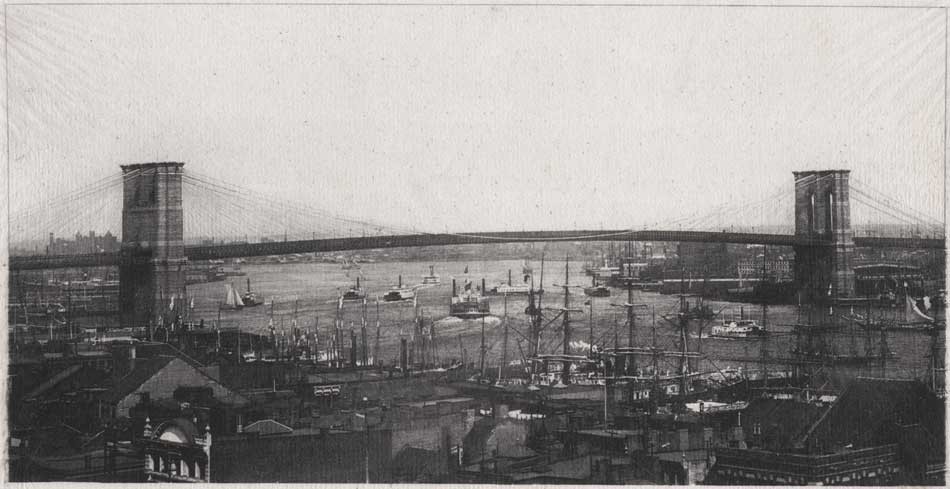 “Brooklyn Bridge”: Adolph A. Wittemann, American (1845-1938). Vintage Japan-tissue photogravure: 1889: printed ca. 1897-1900: Photogravure and Color Co. (New York): 8.8 x 17.1 | 12.6 x 19.7 cm | supports: 20.6 x 28.0 | 22.2 x 29.1 cm. Ferries and other marine craft navigate the East River in this pictorial view emphasizing the span of the famous bridge by Wittemann. Conversely, in a gelatin silver variant held by the Museum of the City of New York: “Looking over New York toward the Brooklyn Bridge”, (x2010.11.3891) the foreground frame shows a greater concentration of buildings and less river activity. In 1890,The Getty Research Institute’s Art & Architecture Thesaurus notes, Adolph Wittemann and his brother Herman would found The Albertype Company, a Brooklyn-based publisher employing the collotype (or albertype) photographic process. “The company operated from 1890 to 1952 and produced over 25,000 prints. The Albertype Company both produced their own photographs (Adolph was a photographer), as well as reproduced photographic images produced by other companies or individual photographers. Using the prints, the company published postcards and viewbooks. Viewbooks, also known as souvenir albums or view albums, are books that contain commercially published groups of photographs depicting a place, activity, or event.” From: PhotoSeed Archive
“Brooklyn Bridge”: Adolph A. Wittemann, American (1845-1938). Vintage Japan-tissue photogravure: 1889: printed ca. 1897-1900: Photogravure and Color Co. (New York): 8.8 x 17.1 | 12.6 x 19.7 cm | supports: 20.6 x 28.0 | 22.2 x 29.1 cm. Ferries and other marine craft navigate the East River in this pictorial view emphasizing the span of the famous bridge by Wittemann. Conversely, in a gelatin silver variant held by the Museum of the City of New York: “Looking over New York toward the Brooklyn Bridge”, (x2010.11.3891) the foreground frame shows a greater concentration of buildings and less river activity. In 1890,The Getty Research Institute’s Art & Architecture Thesaurus notes, Adolph Wittemann and his brother Herman would found The Albertype Company, a Brooklyn-based publisher employing the collotype (or albertype) photographic process. “The company operated from 1890 to 1952 and produced over 25,000 prints. The Albertype Company both produced their own photographs (Adolph was a photographer), as well as reproduced photographic images produced by other companies or individual photographers. Using the prints, the company published postcards and viewbooks. Viewbooks, also known as souvenir albums or view albums, are books that contain commercially published groups of photographs depicting a place, activity, or event.” From: PhotoSeed Archive
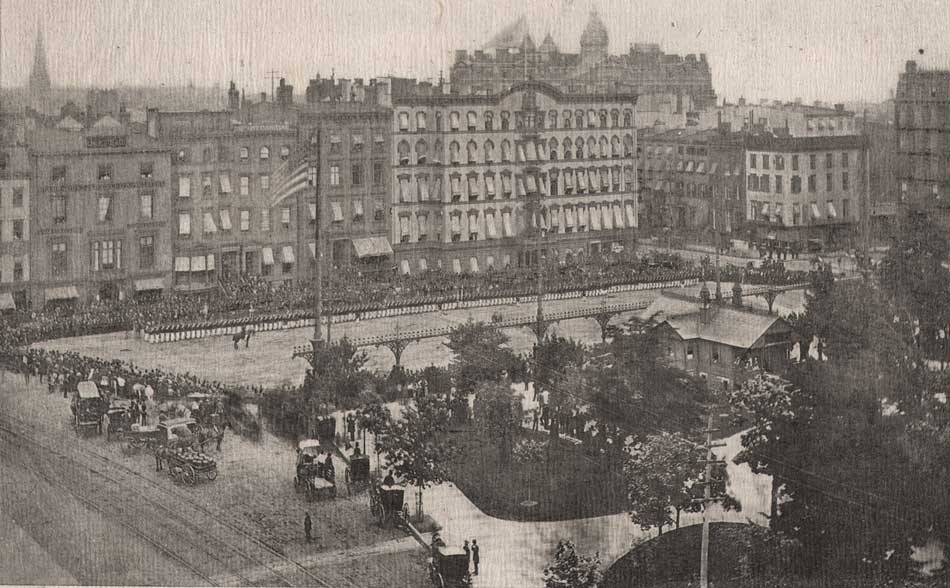 Detail: “Union Square”: unknown American photographer. Vintage Japan-tissue photogravure: ca. 1880-1900: printed ca. 1897-1900: Photogravure and Color Co. (New York): 10.8 x 16.4 | 14.5 x 18.8 cm | supports: 19.1 x 24.5 | 22.2 x 29.1 cm. Soldiers, possibly Cadets from the U.S. Military Academy at West Point, assemble in parade formation (Washington’s Birthday?) two abreast on the north side of Union Square in New York City. Everett House, a fine residential hotel that opened in 1853 at background center of photograph can be seen, and other clues might help a modern viewer more accurately date this view. They include an American flag flying at center, horse-drawn carriages at foreground left, a telegraph pole at foreground right and intact signs (upon close-magnification) on the building at far background left, directly behind the head of the line of soldiers. Located at 29 East 17th Street, it was the warehouse and shop for L. Marcotte & Co., a manufacturer and importer of fine carpets, furniture, and “looking glass plates, frames, gas fixtures, bronzes, and all articles of art”, according to an 1876 sales invoice, and is believed to have been at this location as early as 1860. From: PhotoSeed Archive
Detail: “Union Square”: unknown American photographer. Vintage Japan-tissue photogravure: ca. 1880-1900: printed ca. 1897-1900: Photogravure and Color Co. (New York): 10.8 x 16.4 | 14.5 x 18.8 cm | supports: 19.1 x 24.5 | 22.2 x 29.1 cm. Soldiers, possibly Cadets from the U.S. Military Academy at West Point, assemble in parade formation (Washington’s Birthday?) two abreast on the north side of Union Square in New York City. Everett House, a fine residential hotel that opened in 1853 at background center of photograph can be seen, and other clues might help a modern viewer more accurately date this view. They include an American flag flying at center, horse-drawn carriages at foreground left, a telegraph pole at foreground right and intact signs (upon close-magnification) on the building at far background left, directly behind the head of the line of soldiers. Located at 29 East 17th Street, it was the warehouse and shop for L. Marcotte & Co., a manufacturer and importer of fine carpets, furniture, and “looking glass plates, frames, gas fixtures, bronzes, and all articles of art”, according to an 1876 sales invoice, and is believed to have been at this location as early as 1860. From: PhotoSeed Archive
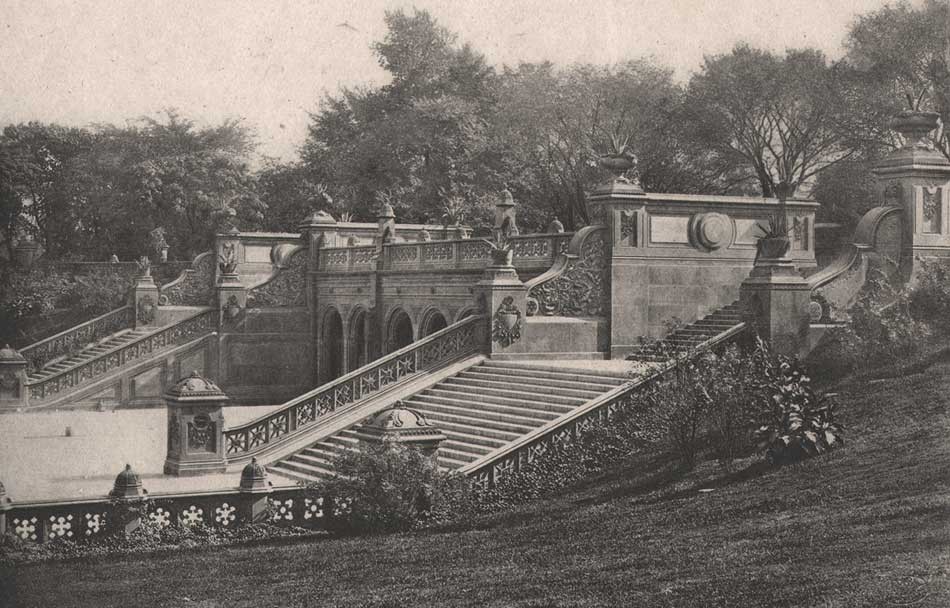 “Central Park” (Bethesda Terrace Steps): unknown American photographer. Vintage Japan-tissue photogravure: ca. 1885-1888: printed ca. 1897-1900: Photogravure and Color Co. (New York): 11.2 x 16.5 | 14.7 x 19.3 cm | supports: 19.8 x 25.3 | 22.2 x 29.1 cm. The Central Park Conservancy considers Bethesda Terrace- “the heart of Central Park and is, by design, its singular formal feature. Overlooking the Lake, it stands at the end of the Park’s long, tree-lined promenade known as the Mall. A grand staircase descends into the subterranean Arcade, which offers a welcome respite from rain and heat.” Shown in this photograph are the two flanking grand staircases for the terrace, designed by park architects Calvert Vaux with sculptural details by Jacob Wrey Mould. Although American commercial photographer John S. Johnston (c.1839-1899) was known to have documented features in Central Park in 1893-94, albeit with people in his views, this photograph, titled “Central Park-The Terrace and Grand Stairway”, first appeared in 1888 in the volume The Empire State: Its Industries and Wealth. (p.45) Later, it was included as part of a series of four architectural studies of Central Park bridges in the 1896 volume The Engineering Magazine, Vol. 11. (“The Terrace”: p. 863) The work was further published as “Terrace Steps, Central Park”- an offset color lithograph print souvenir inserted within the pages of The New York Recorder newspaper between 1891-96: see New York Public Library catalog ID (B-number): b17094307. From: PhotoSeed Archive
“Central Park” (Bethesda Terrace Steps): unknown American photographer. Vintage Japan-tissue photogravure: ca. 1885-1888: printed ca. 1897-1900: Photogravure and Color Co. (New York): 11.2 x 16.5 | 14.7 x 19.3 cm | supports: 19.8 x 25.3 | 22.2 x 29.1 cm. The Central Park Conservancy considers Bethesda Terrace- “the heart of Central Park and is, by design, its singular formal feature. Overlooking the Lake, it stands at the end of the Park’s long, tree-lined promenade known as the Mall. A grand staircase descends into the subterranean Arcade, which offers a welcome respite from rain and heat.” Shown in this photograph are the two flanking grand staircases for the terrace, designed by park architects Calvert Vaux with sculptural details by Jacob Wrey Mould. Although American commercial photographer John S. Johnston (c.1839-1899) was known to have documented features in Central Park in 1893-94, albeit with people in his views, this photograph, titled “Central Park-The Terrace and Grand Stairway”, first appeared in 1888 in the volume The Empire State: Its Industries and Wealth. (p.45) Later, it was included as part of a series of four architectural studies of Central Park bridges in the 1896 volume The Engineering Magazine, Vol. 11. (“The Terrace”: p. 863) The work was further published as “Terrace Steps, Central Park”- an offset color lithograph print souvenir inserted within the pages of The New York Recorder newspaper between 1891-96: see New York Public Library catalog ID (B-number): b17094307. From: PhotoSeed Archive
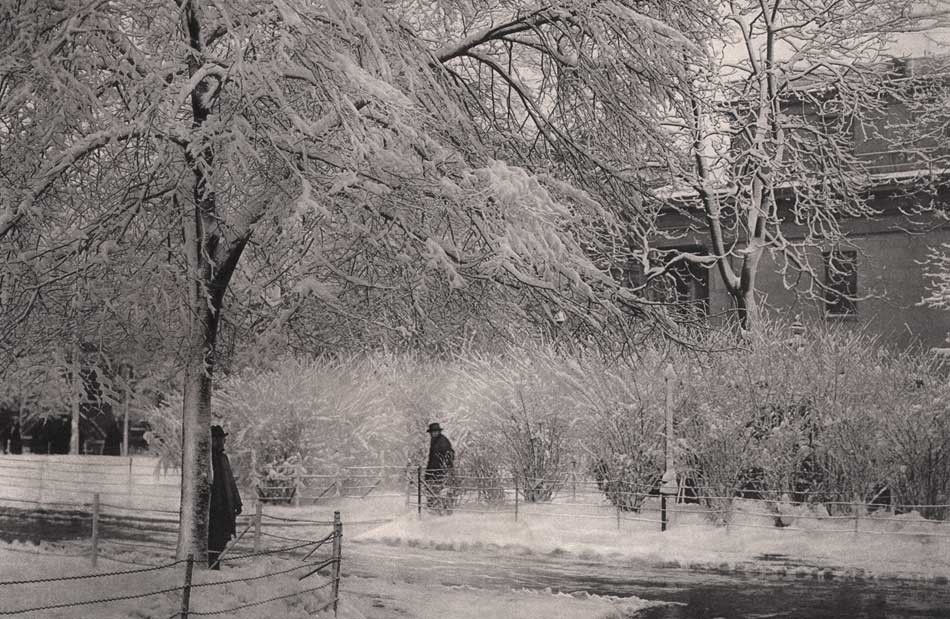 “City Hall Park, New York, March 2, 1896”: William H. Cooper, American. Vintage hand-pulled photogravure by the N.Y. Photogravure Co.: 18.0 x 22.9 | 27.6 x 34.8 cm. Plate issued with the March, 1896 Whole # 91 monthly issue of “Sun and Shade, An Artistic Periodical”. Snow from a late Winter storm coats trees and nearly everything else in New York City’s City Hall Park. From Wikipedia: “City Hall Park is a public park surrounding New York City Hall in the Civic Center of Manhattan. It was the town commons of the nascent city of New York… During the pre-Revolutionary and Revolutionary eras, City Hall Park was the site of many rallies and movements.” Photographer William H. Cooper was the President of the Department of Photography at the Brooklyn Institute of Arts and Science when this photograph was published. The editors of Sun and Shade commented on this work: “The present picture, taken it may be noted for technical readers, by a 2A Zeiss lens, is, without exception, one of the most remarkable productions, so far, which photography has produced. Every one who has seen the strange and peculiar aspect of leafless trees, when showered with fleecy snow, has longed to carry in his mind the memory of the pretty sight: but, until now, it is doubtful if such a weird aspect has ever been perpetuated; certainly not by the hand of a painter, for it would be far and away beyond any artist’s powers.” From: PhotoSeed Archive
“City Hall Park, New York, March 2, 1896”: William H. Cooper, American. Vintage hand-pulled photogravure by the N.Y. Photogravure Co.: 18.0 x 22.9 | 27.6 x 34.8 cm. Plate issued with the March, 1896 Whole # 91 monthly issue of “Sun and Shade, An Artistic Periodical”. Snow from a late Winter storm coats trees and nearly everything else in New York City’s City Hall Park. From Wikipedia: “City Hall Park is a public park surrounding New York City Hall in the Civic Center of Manhattan. It was the town commons of the nascent city of New York… During the pre-Revolutionary and Revolutionary eras, City Hall Park was the site of many rallies and movements.” Photographer William H. Cooper was the President of the Department of Photography at the Brooklyn Institute of Arts and Science when this photograph was published. The editors of Sun and Shade commented on this work: “The present picture, taken it may be noted for technical readers, by a 2A Zeiss lens, is, without exception, one of the most remarkable productions, so far, which photography has produced. Every one who has seen the strange and peculiar aspect of leafless trees, when showered with fleecy snow, has longed to carry in his mind the memory of the pretty sight: but, until now, it is doubtful if such a weird aspect has ever been perpetuated; certainly not by the hand of a painter, for it would be far and away beyond any artist’s powers.” From: PhotoSeed Archive
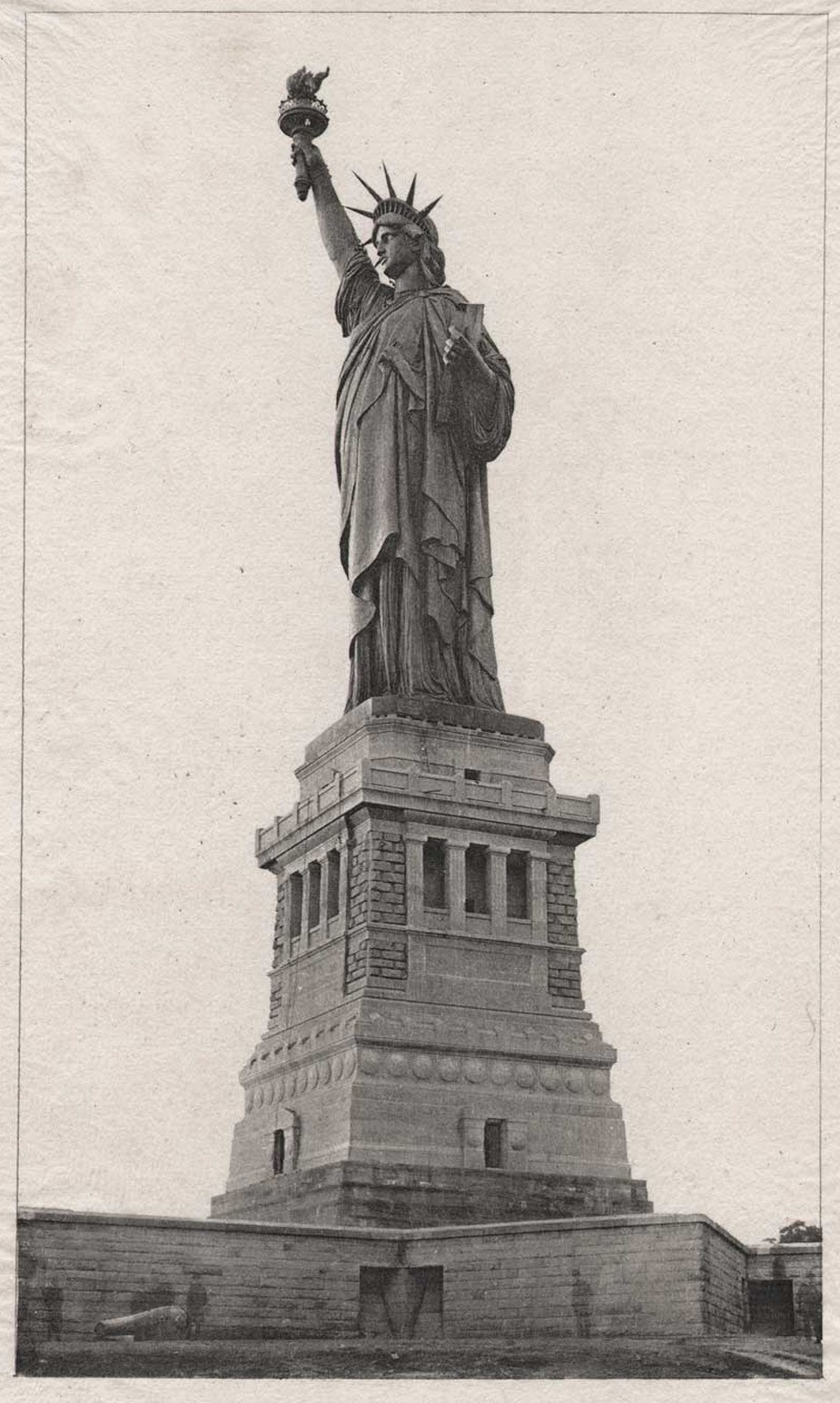 “Statue of Liberty”: Edward H. Hart, American photographer. Vintage Japan-tissue photogravure: 1886: printed ca. 1897-1900: Photogravure and Color Co. (New York): 17.2 x 10.1 | 20.9 x 12.5 cm | supports: 23.5 x 20.0 | 29.0 x 22.2 cm. This rare view of the Statue of Liberty (Liberty Enlightening the World) in New York Harbor was taken in the year it was officially dedicated, which took place October 28, 1886. E.H. Hart was a New York City based photographer with a studio at 1162 Broadway when contracted by the Photo-Gravure Co. of New York in 1886 to make several views of the statue. The company copyrighted one of these that year, titling it “Liberty”. A surviving example in the form of a mounted woodburytype process photograph is held by the National Archives at College Park in the U.S. state of Maryland. (Identifier: 45701938) This variant view by Hart includes the intriguing presence of six people who appear as “ghosts” at the base of the pedestal to the statue, their likeness due to movement during the long time-exposure required. The photographer billed himself an official U.S. Naval photographer, although it’s unclear if he was actually an employee of the Federal Government. A contract photographer for the Detroit Publishing Company in the late 19th Century, he was the author and publisher of the 1898 volume “The Authentic Photographic Views of the United States Navy”. From: PhotoSeed Archive
“Statue of Liberty”: Edward H. Hart, American photographer. Vintage Japan-tissue photogravure: 1886: printed ca. 1897-1900: Photogravure and Color Co. (New York): 17.2 x 10.1 | 20.9 x 12.5 cm | supports: 23.5 x 20.0 | 29.0 x 22.2 cm. This rare view of the Statue of Liberty (Liberty Enlightening the World) in New York Harbor was taken in the year it was officially dedicated, which took place October 28, 1886. E.H. Hart was a New York City based photographer with a studio at 1162 Broadway when contracted by the Photo-Gravure Co. of New York in 1886 to make several views of the statue. The company copyrighted one of these that year, titling it “Liberty”. A surviving example in the form of a mounted woodburytype process photograph is held by the National Archives at College Park in the U.S. state of Maryland. (Identifier: 45701938) This variant view by Hart includes the intriguing presence of six people who appear as “ghosts” at the base of the pedestal to the statue, their likeness due to movement during the long time-exposure required. The photographer billed himself an official U.S. Naval photographer, although it’s unclear if he was actually an employee of the Federal Government. A contract photographer for the Detroit Publishing Company in the late 19th Century, he was the author and publisher of the 1898 volume “The Authentic Photographic Views of the United States Navy”. From: PhotoSeed Archive
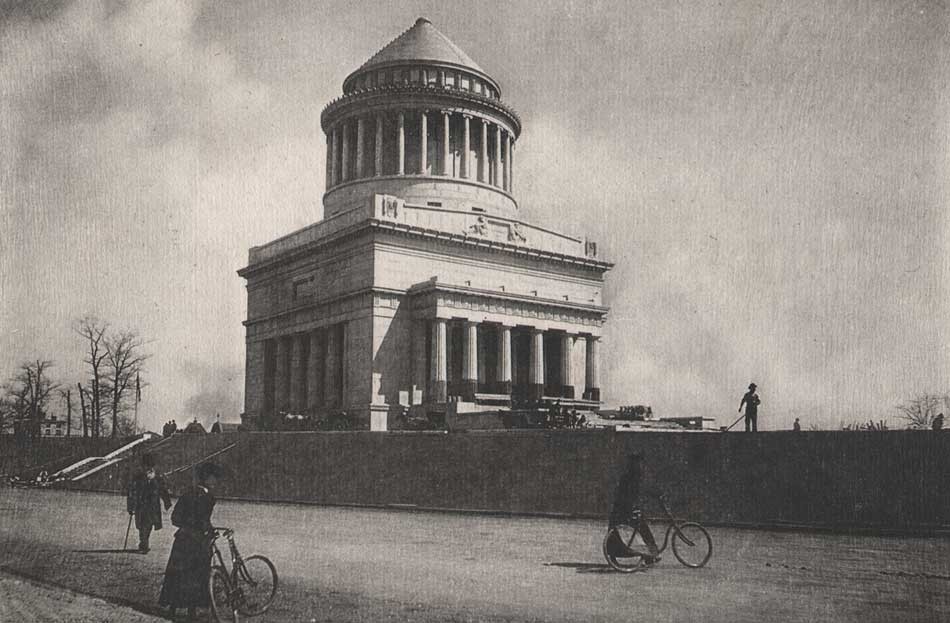 “Grant Memorial”: John S. Johnston, American photographer, born England or Ireland. (c.1839-1899). Vintage Japan-tissue photogravure: 1897: printed ca. 1897-1900: Photogravure and Color Co. (New York): 10.6 x 14.8 | 14.5 x 17.4 cm | supports: 19.5 x 24.5 | 22.2 x 29.0 cm. Taken in early 1897, this New York City view shows bicyclists on Riverside Drive with the soon to be opened General Grant National Memorial in the background. Known more commonly as Grant’s Tomb, it is located in the Morningside Heights neighborhood of Upper Manhattan. The massive domed mausoleum in the Neoclassical style is the final resting place for American Civil War General and 18th President of the United States Ulysses S. Grant. (1822-1885) Grant led the Union Army as Commanding General of the United States Army in winning the American Civil War. A close inspection of this photograph reveals ongoing work to the front stairwell area to the memorial, with large boards erected lengthwise against the base of the large columns. It was dedicated on April 27, 1897, the 75th-anniversary ceremony of Grant's birth on April 27, 1822. A known variant giving credit to Johnston is held privately, along with another more frontal view of the memorial and one example believed to be this very image at The Library of Congress. The library holds approximately 750 dry plate glass negatives of yachts and other marine craft views taken by Johnston when he was a contract photographer for the Detroit Publishing Company. A New York Times obituary for the photographer noted he “made a specialty of scenic photography. He photographed most of the United States warships during the war with Spain. He also photographed all of the international yacht races during the past ten years.” From: PhotoSeed Archive
“Grant Memorial”: John S. Johnston, American photographer, born England or Ireland. (c.1839-1899). Vintage Japan-tissue photogravure: 1897: printed ca. 1897-1900: Photogravure and Color Co. (New York): 10.6 x 14.8 | 14.5 x 17.4 cm | supports: 19.5 x 24.5 | 22.2 x 29.0 cm. Taken in early 1897, this New York City view shows bicyclists on Riverside Drive with the soon to be opened General Grant National Memorial in the background. Known more commonly as Grant’s Tomb, it is located in the Morningside Heights neighborhood of Upper Manhattan. The massive domed mausoleum in the Neoclassical style is the final resting place for American Civil War General and 18th President of the United States Ulysses S. Grant. (1822-1885) Grant led the Union Army as Commanding General of the United States Army in winning the American Civil War. A close inspection of this photograph reveals ongoing work to the front stairwell area to the memorial, with large boards erected lengthwise against the base of the large columns. It was dedicated on April 27, 1897, the 75th-anniversary ceremony of Grant's birth on April 27, 1822. A known variant giving credit to Johnston is held privately, along with another more frontal view of the memorial and one example believed to be this very image at The Library of Congress. The library holds approximately 750 dry plate glass negatives of yachts and other marine craft views taken by Johnston when he was a contract photographer for the Detroit Publishing Company. A New York Times obituary for the photographer noted he “made a specialty of scenic photography. He photographed most of the United States warships during the war with Spain. He also photographed all of the international yacht races during the past ten years.” From: PhotoSeed Archive
Window Gazing
Posted April 2020 in New Additions
Patience - A Haiku
Premonition bound
A great, hopeful patience sleeps
beyond the window
⎯ Apologies: Poem Generator
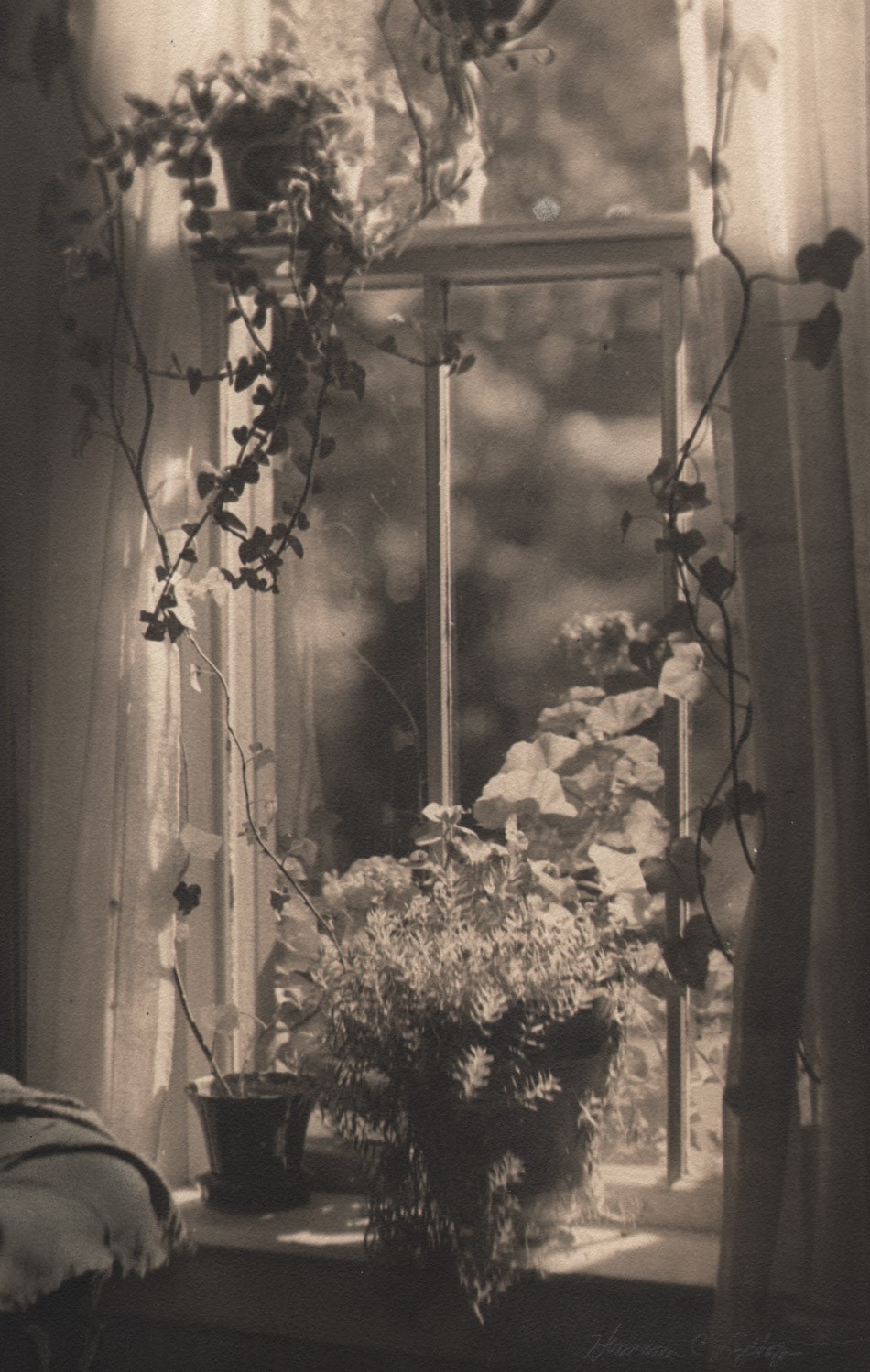 Detail: “The Winter Garden” Hermann Charles Lythgoe (1874-1962), American: vintage unmounted bromide print ca. 1920-40: (31.2 x 16.9 cm) Houseplants and flowers compete for sunlight on interior windowsills in this study by accomplished Boston-area amateur photographer Hermann Lythgoe. A chemist by training, he graduated from the Massachusetts Institute of Technology (MIT) in 1896 and went on to become the longtime Director for the Division of Food and Drugs at the Massachusetts Department of Public Health in Boston. From: PhotoSeed Archive
Detail: “The Winter Garden” Hermann Charles Lythgoe (1874-1962), American: vintage unmounted bromide print ca. 1920-40: (31.2 x 16.9 cm) Houseplants and flowers compete for sunlight on interior windowsills in this study by accomplished Boston-area amateur photographer Hermann Lythgoe. A chemist by training, he graduated from the Massachusetts Institute of Technology (MIT) in 1896 and went on to become the longtime Director for the Division of Food and Drugs at the Massachusetts Department of Public Health in Boston. From: PhotoSeed ArchivePhotograph: Meet Frame
Posted February 2020 in Conservation, Framing, New Additions, Photographic Preservation, PhotoSeed, Significant Photographers
Last August I had the uncommon opportunity to purchase five photographs ca. 1905-1910 that were still in their original picture frames taken by William T. Knox, (1863-1927) then president of the Brooklyn Camera Club.
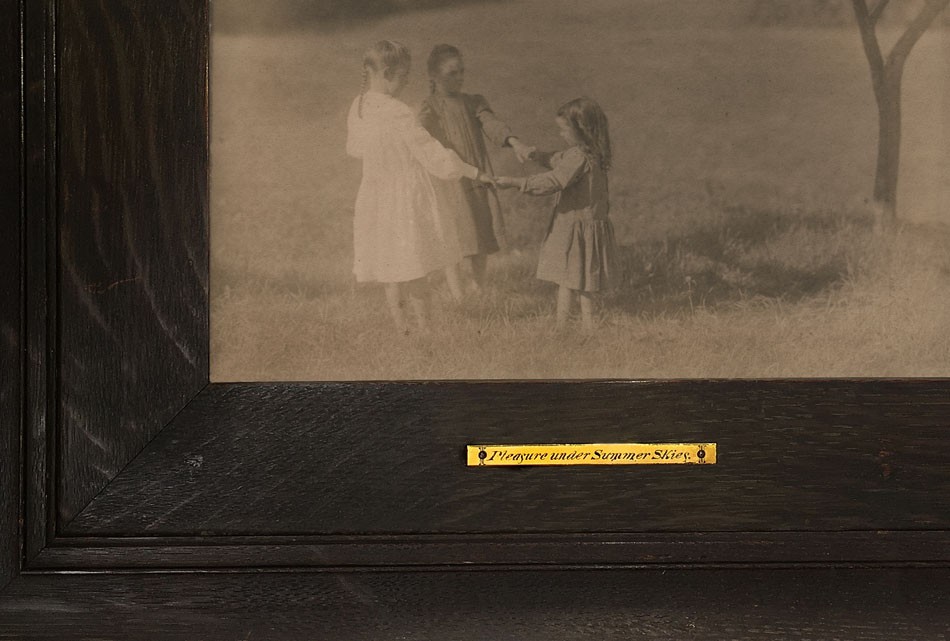 Detail: “Pleasure Under Summer Skies”: William T. Knox, American: (1863-1927) Vintage sepia Platinum print ca. 1905-10; 19.6 x 24.5 | 19.6 x 24.5 cm (flush-mounted on Bristol-board type matrix). Photograph framed in quarter-sawn oak frame with brass title nameplate made by James Engle Underhill, American: (1870-1914) two-piece integrated: 34.5 x 39.5 x 2.0 cm shown with glass removed. “Pleasure Under Summer Skies” dates to 1905, and was initially exhibited in the Second American Photographic Salon, overseen by the American Federation of Photographic Societies under President Curtis Bell. At the time, William Knox was Federation Secretary. From: PhotoSeed Archive
Detail: “Pleasure Under Summer Skies”: William T. Knox, American: (1863-1927) Vintage sepia Platinum print ca. 1905-10; 19.6 x 24.5 | 19.6 x 24.5 cm (flush-mounted on Bristol-board type matrix). Photograph framed in quarter-sawn oak frame with brass title nameplate made by James Engle Underhill, American: (1870-1914) two-piece integrated: 34.5 x 39.5 x 2.0 cm shown with glass removed. “Pleasure Under Summer Skies” dates to 1905, and was initially exhibited in the Second American Photographic Salon, overseen by the American Federation of Photographic Societies under President Curtis Bell. At the time, William Knox was Federation Secretary. From: PhotoSeed Archive
Additionally, three of them were in beautiful wood frames made by his fellow club member James E. Underhill, 1870-1914, who I discovered had made his living as a fine picture framer since around 1900 in New York City at his shop at 33 John Street, at the corner of Nassau Street.
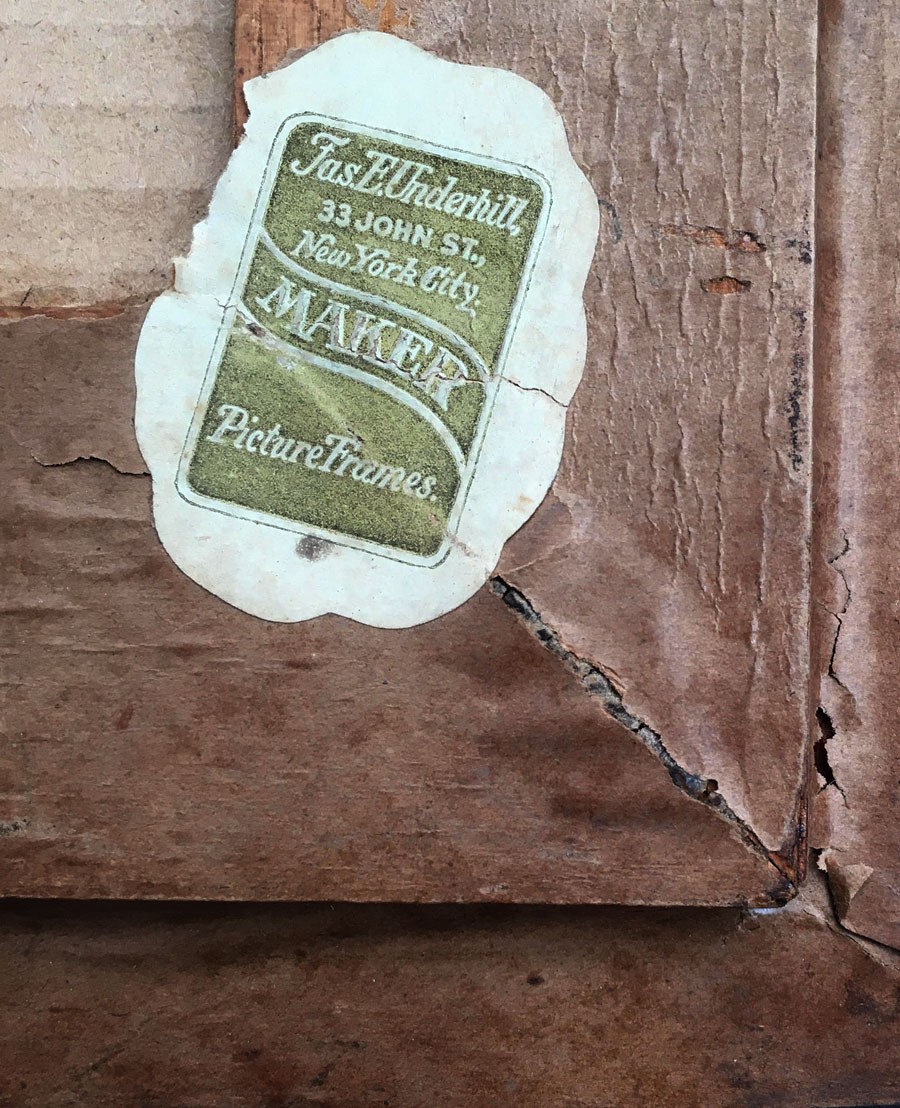 Before limited conservation, the original James E. Underhill white-paper letterpress label in olive-green (2.9 x 2.0 | 4.3 x 3.2 cm) is seen affixed to the frame backing verso of his oak frame enclosing the William T. Knox photograph “Pleasure Under Summer Skies”. Conservation treatment by this archive carefully left this label in place. James Engle Underhill was a fellow member along with Knox at the Brooklyn Camera Club when this photograph was taken and framed. (ca. 1905-10) Underhill’s picture framing shop: “Jas.E.Underhill, 33 John St., New York City. MAKER PictureFrames.” was in operation at this location (corner Nassau) from around 1900 to his death in 1914. From: PhotoSeed Archive
Before limited conservation, the original James E. Underhill white-paper letterpress label in olive-green (2.9 x 2.0 | 4.3 x 3.2 cm) is seen affixed to the frame backing verso of his oak frame enclosing the William T. Knox photograph “Pleasure Under Summer Skies”. Conservation treatment by this archive carefully left this label in place. James Engle Underhill was a fellow member along with Knox at the Brooklyn Camera Club when this photograph was taken and framed. (ca. 1905-10) Underhill’s picture framing shop: “Jas.E.Underhill, 33 John St., New York City. MAKER PictureFrames.” was in operation at this location (corner Nassau) from around 1900 to his death in 1914. From: PhotoSeed Archive
In my 20+ years of collecting photography, and with a definite impression the “bloom is off the rose” when it comes to the intersection of internet commerce, it seems to me today more difficult to acquire vintage photographs of artistic note still in their original frames. This is a pity, because framed photographs left undisturbed from 100+ years ago can often reveal the more honest intent photographers wished for their work to be seen and appreciated- for the time they were created no doubt, but also on a higher aesthetic level.
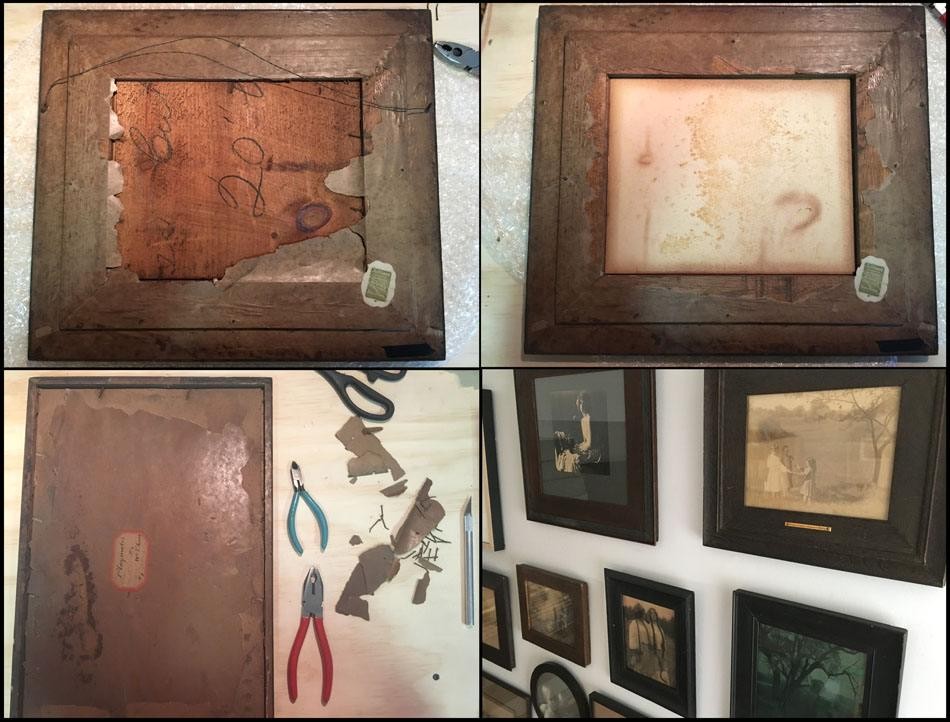 Upper left: When first received by PhotoSeed after purchase in late August, 2019, the verso of the framed William T. Knox photograph “Pleasure Under Summer Skies” is seen in its’ original James E. Underhill oak frame. As was common in framed works from the late 19th and early 20th centuries, a thin sheet of pine wood veneer was used as a backing board, secured by small nails. Upper Right: Conservation treatment on the framed work included removal of this wood backing board along with rusted screw-eyes and wiring used for hanging as well as some of the frame backing paper. The original Underhill framing label is carefully left undisturbed at lower right and the Bristol-board type matrix with flush-mounted photograph on recto is revealed, showing the “burning in” of several wood knot holes from the recto of the original sheet of wood veneer. Next steps included the thorough cleaning of the original framing glass and then cutting a piece of acid-free, 4-ply mat board that would be sandwiched between the photographic matrix and new piece of cardboard backing board. Finally, a Fletcher brand framing gun was used to secure glass, mounted photograph and the two separate backing matrixes using new metal framer’s points to the inside perimeter of the frame verso. Lower Left: Tools at right including small pliers and a wire-cutter were used to remove the original verso framing nails from the William T. Knox photograph “Playmates”, along with an X-Acto knife at far right to cut away the delicate and very acidic backing paper. A unique paper label signed and titled by the artist in the middle of the paper was then carefully removed and preserved within a newly encapsulated frame using a piece of acid-free mat board. New flush-mounted hanging hardware (screw-eyes not recommended!) and braided wire were also installed. Lower Right: A selection shows vintage frames with photographs from the PhotoSeed Archive, including the William T. Knox photograph “Pleasure Under Summer Skies”, now re-installed within its’ original James E. Underhill frame at upper right. To the left of it is a separate frame made by Underhill’s contemporary, George F. Of Jr. (1876-1954) From: PhotoSeed Archive
Upper left: When first received by PhotoSeed after purchase in late August, 2019, the verso of the framed William T. Knox photograph “Pleasure Under Summer Skies” is seen in its’ original James E. Underhill oak frame. As was common in framed works from the late 19th and early 20th centuries, a thin sheet of pine wood veneer was used as a backing board, secured by small nails. Upper Right: Conservation treatment on the framed work included removal of this wood backing board along with rusted screw-eyes and wiring used for hanging as well as some of the frame backing paper. The original Underhill framing label is carefully left undisturbed at lower right and the Bristol-board type matrix with flush-mounted photograph on recto is revealed, showing the “burning in” of several wood knot holes from the recto of the original sheet of wood veneer. Next steps included the thorough cleaning of the original framing glass and then cutting a piece of acid-free, 4-ply mat board that would be sandwiched between the photographic matrix and new piece of cardboard backing board. Finally, a Fletcher brand framing gun was used to secure glass, mounted photograph and the two separate backing matrixes using new metal framer’s points to the inside perimeter of the frame verso. Lower Left: Tools at right including small pliers and a wire-cutter were used to remove the original verso framing nails from the William T. Knox photograph “Playmates”, along with an X-Acto knife at far right to cut away the delicate and very acidic backing paper. A unique paper label signed and titled by the artist in the middle of the paper was then carefully removed and preserved within a newly encapsulated frame using a piece of acid-free mat board. New flush-mounted hanging hardware (screw-eyes not recommended!) and braided wire were also installed. Lower Right: A selection shows vintage frames with photographs from the PhotoSeed Archive, including the William T. Knox photograph “Pleasure Under Summer Skies”, now re-installed within its’ original James E. Underhill frame at upper right. To the left of it is a separate frame made by Underhill’s contemporary, George F. Of Jr. (1876-1954) From: PhotoSeed Archive
On a technical note, PhotoSeed does minimum conservation on framed works when they enter the collection. The mantra of “do no harm” as well as the realization of being temporary custodians of an archive is embraced. When in doubt about proceeding with photographic conservation, advice given me many years ago from a George Eastman Museum conservator to basically just leave things alone when unsure of how to proceed is something I’ve always kept in mind. Of course, the financial realities of proper conservation standards will always be at the forefront for collectors, both private and institutional.
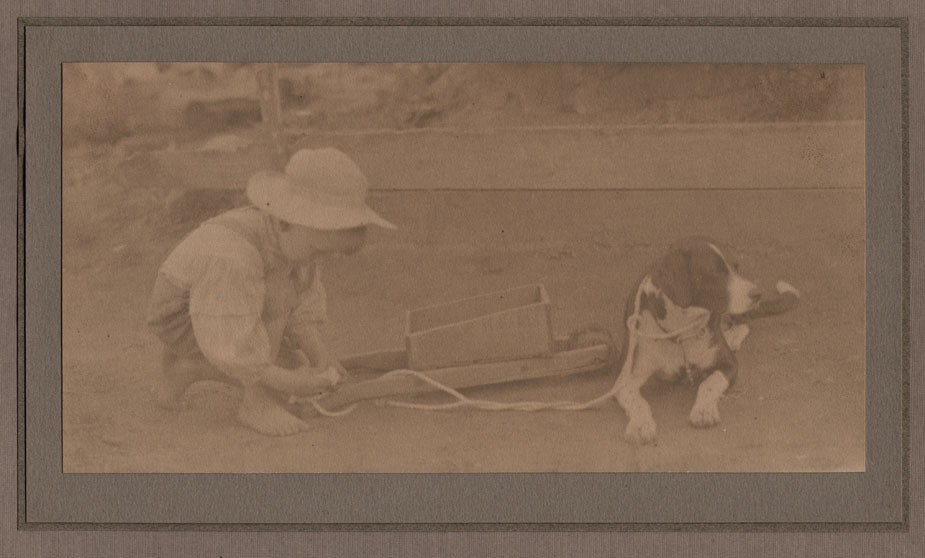 “Playmates”: William T. Knox, American: (1863-1927) Vintage sepia Platinum print ca. 1905-10; image: 12.0 x 23.5 mounted on fine art papers: 19.6 x 24.5 | 19.6 x 24.5 cm. This fine children’s genre study by Brooklyn Camera Club president William T. Knox dates to 1905 or slightly before as it was known to have been exhibited in the Second American Photographic Salon that year. It shows a young child attaching a leash from his faithful canine companion to his toy wooden wheelbarrow. From: PhotoSeed Archive
“Playmates”: William T. Knox, American: (1863-1927) Vintage sepia Platinum print ca. 1905-10; image: 12.0 x 23.5 mounted on fine art papers: 19.6 x 24.5 | 19.6 x 24.5 cm. This fine children’s genre study by Brooklyn Camera Club president William T. Knox dates to 1905 or slightly before as it was known to have been exhibited in the Second American Photographic Salon that year. It shows a young child attaching a leash from his faithful canine companion to his toy wooden wheelbarrow. From: PhotoSeed Archive
Frame Conservation: A Few Ideas
For framed works, conservation on my end typically includes the removal of acidic frame backing materials and replacement with acid-free mounting materials that come into direct contact with the physical print. Embedded dirt and other foreign matter is then carefully removed and or wiped away from the frame itself, with original finishes showing the passing of decades left deliberately intact and never stripped off. Finally, everything is put back together for storage or display: the original glass from the frame is also cleaned on both sides and then carefully put back into place. If cracks are discovered or worse, replacement with a custom cut piece of window glass will typically suffice.
Digital Presentation on PhotoSeed
For digital presentation on this website, the frame is then photographed separately and the print scanned. I use Photoshop to combine the two-leaving the original framing glass out. Purists may object to this but I’m not changing the physical object in any way-just taking advantage to present you with an optimum web experience. Of course, the joy of collecting is being able to appreciate a vintage photograph in the very best form possible: in person. Never the less, I’ve included a small photo along with three other conservation snaps in this post showing a small display of conserved and “reframed” works from this archive. Other examples can be found here.
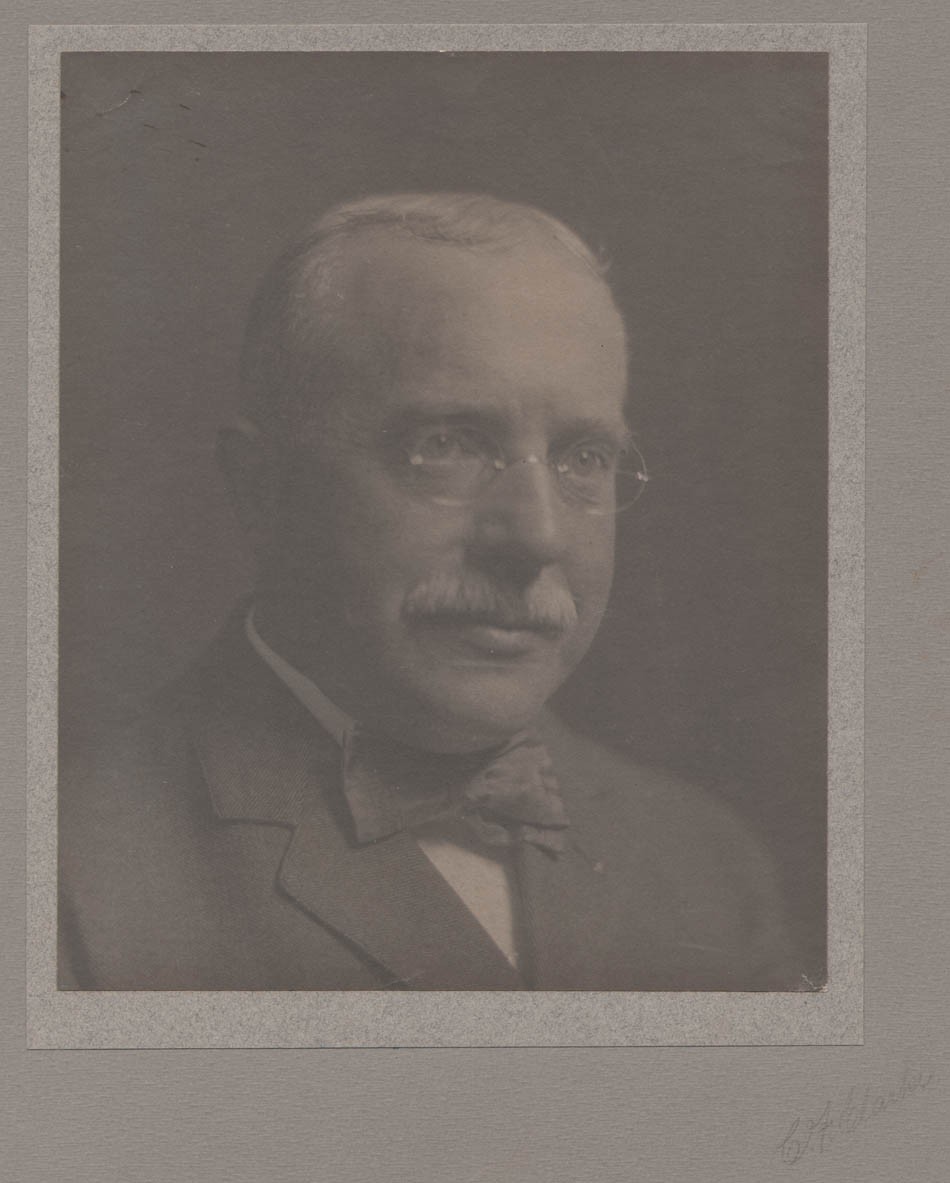 “Portrait: Brooklyn Camera Club President William T. Knox”: Charles Frederick Clarke, American, born Nova Scotia: (1865-1912) image: 21.7 x 17.8 cm; supports: light-gray art paper 23.7 x 19.4 | 36.4 x 29.5 cm; Vintage platinum print ca. 1905-10. William T. Knox (1863-1927) was an important American amateur photographer and promoter of photography from Brooklyn, New York. From at least 1891-1915, he was a partner of McCormick, Hubbs & Co., importers and commission merchants in West India and Florida Fruits and Produce with offices at 279 Washington Street in New York City. (Manhattan) From: PhotoSeed Archive
“Portrait: Brooklyn Camera Club President William T. Knox”: Charles Frederick Clarke, American, born Nova Scotia: (1865-1912) image: 21.7 x 17.8 cm; supports: light-gray art paper 23.7 x 19.4 | 36.4 x 29.5 cm; Vintage platinum print ca. 1905-10. William T. Knox (1863-1927) was an important American amateur photographer and promoter of photography from Brooklyn, New York. From at least 1891-1915, he was a partner of McCormick, Hubbs & Co., importers and commission merchants in West India and Florida Fruits and Produce with offices at 279 Washington Street in New York City. (Manhattan) From: PhotoSeed Archive
Intriguingly, I have owned a platinum portrait of William T. Knox, showing him to be quite the dapper gentleman- mustachioed, and sporting a bow tie taken about the same time he was club president, for many years prior to my collecting any of his actual photographs. This was by Charles F. Clarke, 1865-1912, (American, born Nova Scotia) an amateur and business agent for the Forbes Lithograph Company of Springfield, MA.
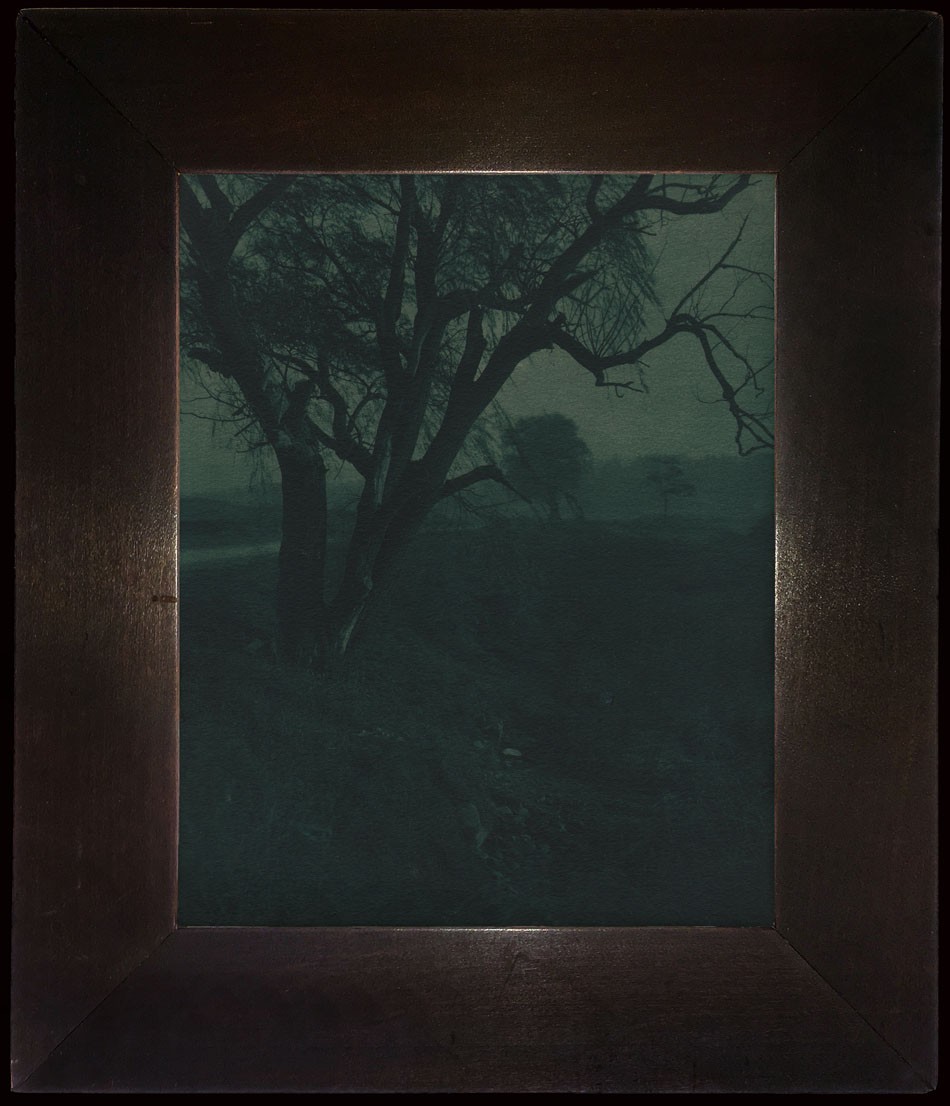 “Landscape in Green Carbon”: attributed to William T. Knox, American: (1863-1927) Vintage green Carbon print ca. 1905-10; image: 23.4 x 19.7 cm flush mounted to thick, Bristol-board type matrix: 23.6 x 19.7 cm shown within its’ original oak frame: 32.6 x 28.6 x 2.0 cm (with glass removed) by James E. Underhill (1870-1914) of New York City. Knox and Underhill were members of the Brooklyn Camera Club when this photograph was taken and framed. From: PhotoSeed Archive
“Landscape in Green Carbon”: attributed to William T. Knox, American: (1863-1927) Vintage green Carbon print ca. 1905-10; image: 23.4 x 19.7 cm flush mounted to thick, Bristol-board type matrix: 23.6 x 19.7 cm shown within its’ original oak frame: 32.6 x 28.6 x 2.0 cm (with glass removed) by James E. Underhill (1870-1914) of New York City. Knox and Underhill were members of the Brooklyn Camera Club when this photograph was taken and framed. From: PhotoSeed Archive
You can see all of Mr. Knox’s framed works in the collection here, which includes a professional chronology for his friend the framer and fellow Brooklyn Camera Club member James E. Underhill. Happy hunting! -David Spencer
Blue Christmas
Posted December 2019 in Alternate Processes, Color Photography, New Additions
⎯ And when the blue snowflakes start falling
That’s when those blue memories start calling
You’ll be doing alright with your Christmas of white,
But I’ll have a blue blue Christmas ✻
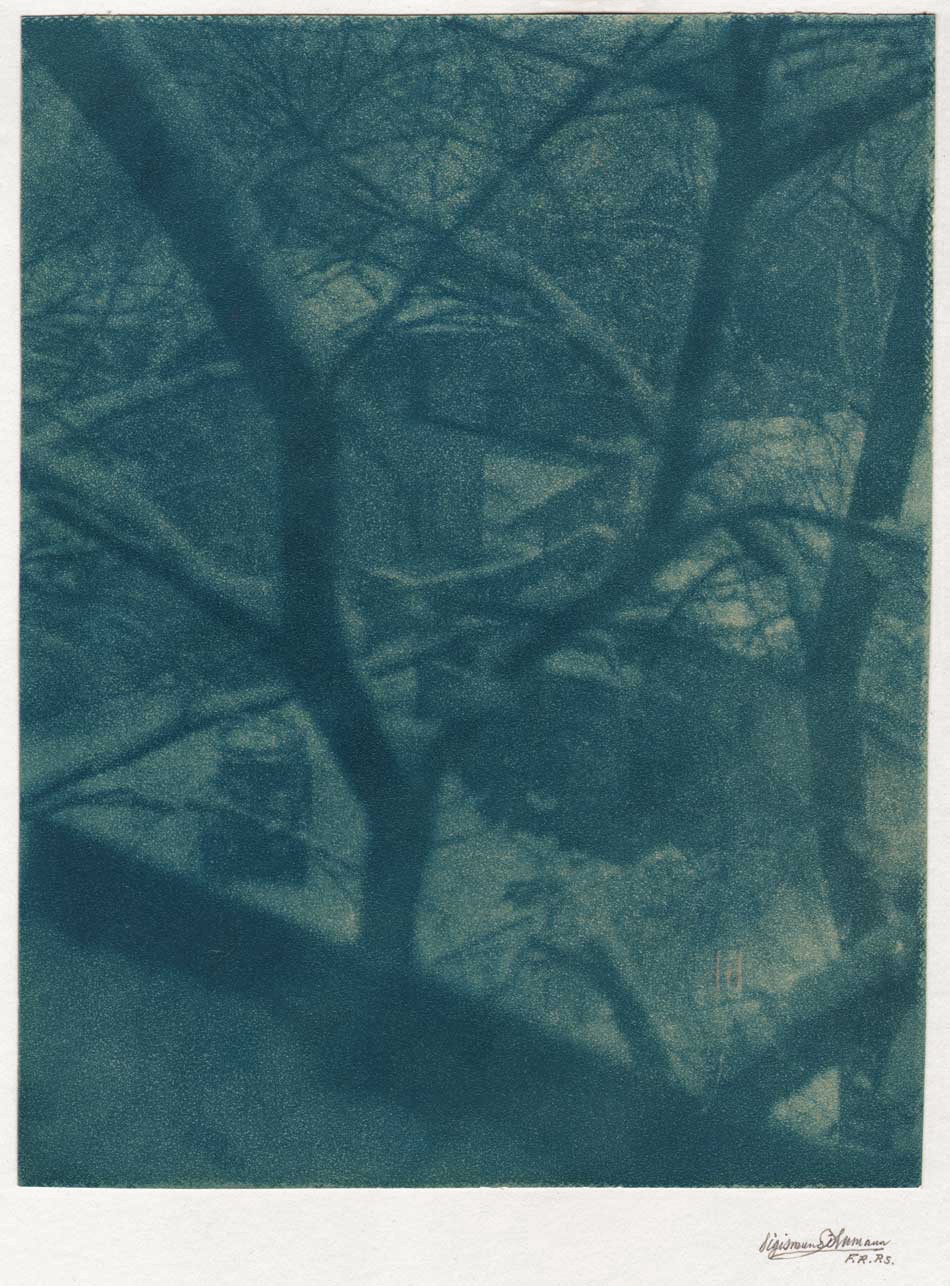 “Christmas Night from an Attic Window”: Sigismund Blumann, American: (1872–1956). Vintage “Lithobrome” (Bromoil transfer) print ca. 1932 or later; 23.6 x 18.3 | 43.3 x 33.0 cm. Photographed from above through tree limbs supporting several inches of snow, this rare wintertime view by noted California pictorialist photographer Sigismund Blumann (1872–1956) shows a home courtyard with parked automobile seen through limbs at lower left. Most likely dating to the late 1920’s, this example printed 1932 or later due to Blumann’s inclusion of his F.R.P.S. affiliation (the year he earned Fellowship in the Royal Photographic Society) within the lower right corner of the primary matt’s impressed window. From: PhotoSeed Archive
“Christmas Night from an Attic Window”: Sigismund Blumann, American: (1872–1956). Vintage “Lithobrome” (Bromoil transfer) print ca. 1932 or later; 23.6 x 18.3 | 43.3 x 33.0 cm. Photographed from above through tree limbs supporting several inches of snow, this rare wintertime view by noted California pictorialist photographer Sigismund Blumann (1872–1956) shows a home courtyard with parked automobile seen through limbs at lower left. Most likely dating to the late 1920’s, this example printed 1932 or later due to Blumann’s inclusion of his F.R.P.S. affiliation (the year he earned Fellowship in the Royal Photographic Society) within the lower right corner of the primary matt’s impressed window. From: PhotoSeed Archive
✻ (lyrics by Billy Hayes & Jay W. Johnson made famous by Elvis Presley on his first Christmas album released in October, 1957)
American Love Story
Posted August 2019 in New Additions, Publishing, Significant Photographs
“And I never saw that love did any harm anywhere or was complained about O my brothers when you understood it:
For that’s about all life comes to anyhow—comes to the love we can put into it:
I just give you what I’ve got, dear comrades.” -Horace Traubel
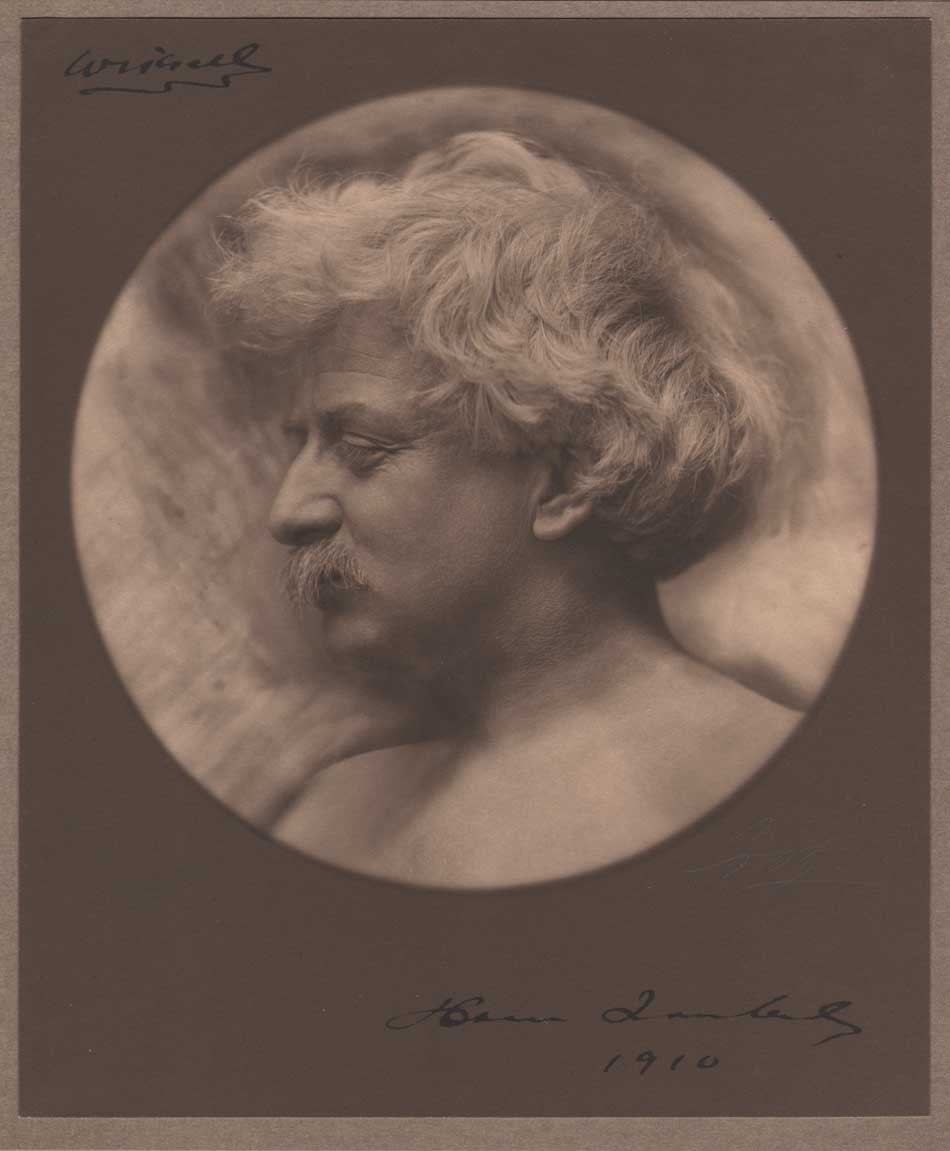 “Horace Traubel: Roundel Portrait” : Allen Drew Cook, American (1871-1923): 1910: mounted platinum print contained within folder: 17.4” roundel on paper 23.7 x 19.6 cm; supports: 24.8 x 20.6 | 28.4 x 23.9 cm. Folder: 29.4 x 48.8 cm. This print dedicated to Gustave Percival Wiksell (1863-1940): “Wiksell” in upper left corner of print recto; signed “Horace Traubel 1910” at lower right. Best remembered as the literary executor and biographer extraordinaire of America’s first national poet Walt Whitman, this uncommon profile portrait features the American editor and poet Horace Logo Traubel. (1858-1919) Traubel, a magazine publisher and committed socialist who held Whitman’s hand on his deathbed and earlier compiled nearly two million words over the the last four years in daily conversations with the poet, later transcribed and ultimately published what would become the nine volume opus: “With Walt Whitman in Camden”. From: PhotoSeed Archive
“Horace Traubel: Roundel Portrait” : Allen Drew Cook, American (1871-1923): 1910: mounted platinum print contained within folder: 17.4” roundel on paper 23.7 x 19.6 cm; supports: 24.8 x 20.6 | 28.4 x 23.9 cm. Folder: 29.4 x 48.8 cm. This print dedicated to Gustave Percival Wiksell (1863-1940): “Wiksell” in upper left corner of print recto; signed “Horace Traubel 1910” at lower right. Best remembered as the literary executor and biographer extraordinaire of America’s first national poet Walt Whitman, this uncommon profile portrait features the American editor and poet Horace Logo Traubel. (1858-1919) Traubel, a magazine publisher and committed socialist who held Whitman’s hand on his deathbed and earlier compiled nearly two million words over the the last four years in daily conversations with the poet, later transcribed and ultimately published what would become the nine volume opus: “With Walt Whitman in Camden”. From: PhotoSeed Archive
In this 200th anniversary year of American poet Walt Whitman’s birth, articles and exhibitions abound, celebrating the continuing relevance of America’s “Bard of Democracy”. But who was largely responsible for initially preserving, and thus memorializing for a larger audience this most important literary voice? A gentleman by the name of Horace Traubel. (1858-1919)
Three years ago I had the good fortune of purchasing a heraldic roundel portrait of Traubel, the one featured above taken by a fellow Philadelphian, pictorialist photographer Allen Drew Cook. (1871-1923)
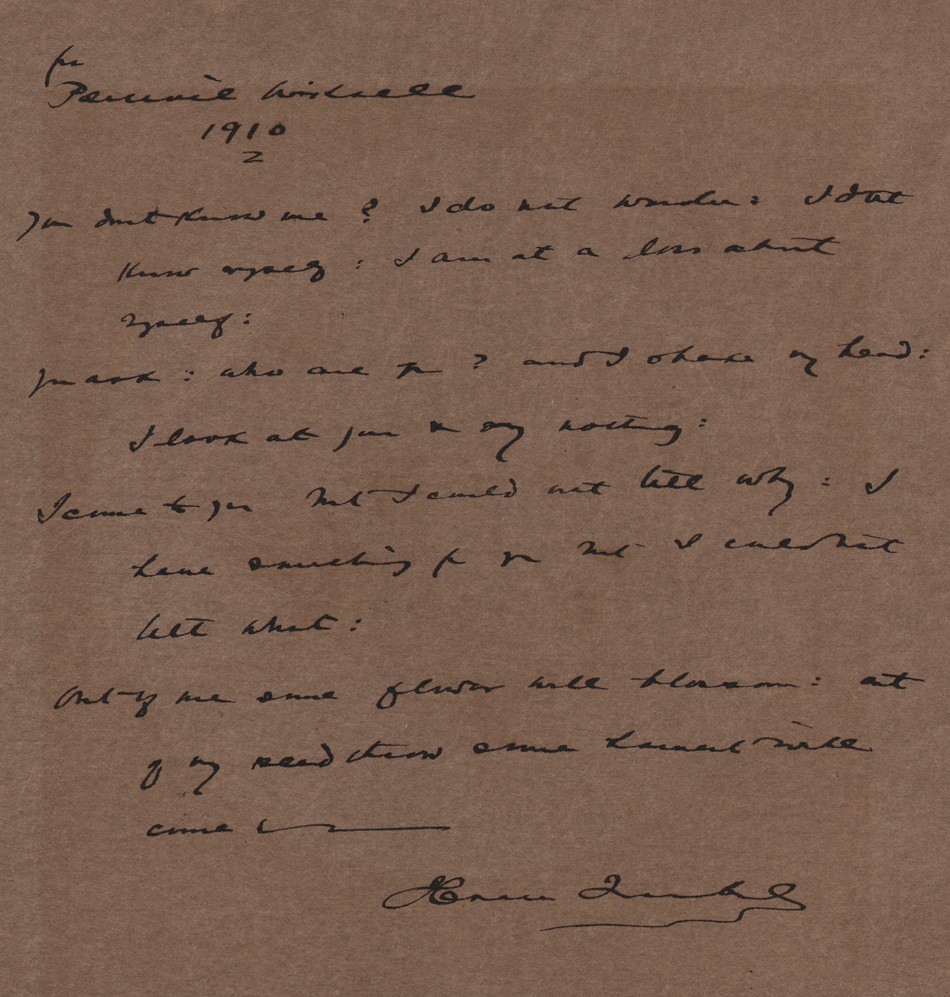 Lines addressed to Gustave Percival Wiksell (1863-1940) from the Horace Traubel poem “I Just Give You What I’ve Got” (from “Optimos”- 1910) in hand of author on inside front cover to folder containing photograph “Horace Traubel: Roundel Portrait”. Wiksell was a Boston dentist who served as president of the Walt Whitman Fellowship from 1903-1919. “You don't know me? I do not wonder: I dont know myself: I am at a loss about myself: You ask: who are you? and I shake my head : I look at you and say nothing: I come to you but I could not tell why: I have something for you but I could not tell what: Out of me some flower will blossom out of my seedthrow some harvest will come. - Horace Traubel”. Writing in the Mickle Street Review No. 16, (2004) U.S. scholar Michael Robertson’s article “The Gospel According To Horace: Horace Traubel And The Walt Whitman Fellowship” outlines Traubel’s and Wiksell’s relationship: “However, Traubel’s letters to Wiksell move beyond comradeship into physically explicit expressions of desire. “I dream of … the little bed in your paradise and the two arms of a brother that accept me in their divine partnership,”(114) Traubel wrote shortly before traveling to Boston. After his visit, he wrote longingly, “I sit here and write you a letter. It is not a pen that is writing. It is the lips that you have kissed. It is the body that you have traversed over and over with your consecrating palm. Do you not feel that body? Do you not feel the return?”(115) These and other letters leave little doubt that the two men had a sexual love affair, an affair that seems to have been remarkably guilt-free. Wiksell’s letters to Traubel refer to his own wife and child and mix heavy-breathing passion with cheery greetings to “Annie and Gertrude,”(116) Traubel’s wife and daughter.”(114-“I dream of”: Traubel to Wiksell, 3 Jan. 1904, WC.; 115-“I sit here”: Traubel to Wiksell, 12 May 1904, WC.; 116-“Annie and Gertrude”: Wiksell to Traubel, 30 Dec. 1901, TC.) From: PhotoSeed Archive
Lines addressed to Gustave Percival Wiksell (1863-1940) from the Horace Traubel poem “I Just Give You What I’ve Got” (from “Optimos”- 1910) in hand of author on inside front cover to folder containing photograph “Horace Traubel: Roundel Portrait”. Wiksell was a Boston dentist who served as president of the Walt Whitman Fellowship from 1903-1919. “You don't know me? I do not wonder: I dont know myself: I am at a loss about myself: You ask: who are you? and I shake my head : I look at you and say nothing: I come to you but I could not tell why: I have something for you but I could not tell what: Out of me some flower will blossom out of my seedthrow some harvest will come. - Horace Traubel”. Writing in the Mickle Street Review No. 16, (2004) U.S. scholar Michael Robertson’s article “The Gospel According To Horace: Horace Traubel And The Walt Whitman Fellowship” outlines Traubel’s and Wiksell’s relationship: “However, Traubel’s letters to Wiksell move beyond comradeship into physically explicit expressions of desire. “I dream of … the little bed in your paradise and the two arms of a brother that accept me in their divine partnership,”(114) Traubel wrote shortly before traveling to Boston. After his visit, he wrote longingly, “I sit here and write you a letter. It is not a pen that is writing. It is the lips that you have kissed. It is the body that you have traversed over and over with your consecrating palm. Do you not feel that body? Do you not feel the return?”(115) These and other letters leave little doubt that the two men had a sexual love affair, an affair that seems to have been remarkably guilt-free. Wiksell’s letters to Traubel refer to his own wife and child and mix heavy-breathing passion with cheery greetings to “Annie and Gertrude,”(116) Traubel’s wife and daughter.”(114-“I dream of”: Traubel to Wiksell, 3 Jan. 1904, WC.; 115-“I sit here”: Traubel to Wiksell, 12 May 1904, WC.; 116-“Annie and Gertrude”: Wiksell to Traubel, 30 Dec. 1901, TC.) From: PhotoSeed Archive
Best remembered as the literary executor and biographer extraordinaire of Walt Whitman, Horace Traubel was also a magazine publisher and committed socialist who held the poet’s hand on his deathbed and compiled nearly two million words over the last four years in daily conversations with him, later transcribing and publishing in his lifetime the first three volumes of what would become his nine volume opus: With Walt Whitman in Camden. (completed 1996)
Unlike Whitman, whom The Guardian newspaper notes in an article published this year “was also the 19th century’s most photographed American writer”, (1.) there are only a smattering of photographs featuring Traubel-most being credited to Cook. By and large, Horace Traubel is a figure in American letters most people have never heard of.
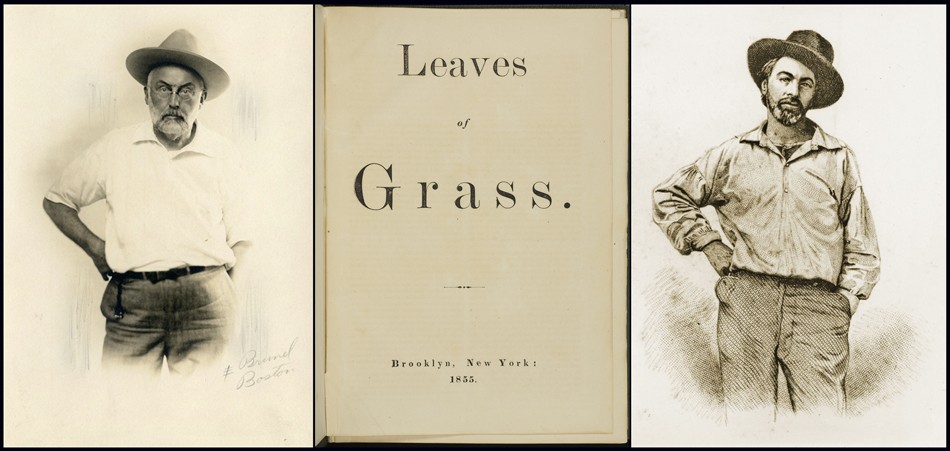 Left: “Gustave Percival Wiksell as Walt Whitman”: Undated gelatin-silver print by Emile Brunel Studio, Boston, ca. 1915-25?: Wearing similar clothing, Wiksell strikes a pose similar to one Whitman made from a lost daguerreotype by Gabriel Harrison later made into a steel engraving by Samuel Hollyer. Boston dentist Gustave Percival Wiksell was an ardent devotee to Walt Whitman and president of the Whitman Fellowship from 1903-19. Photograph © All rights reserved by tackyspoons/flickr. Middle: 1855 first edition title page to Leaves of Grass, Brooklyn, New York. Courtesy The Lilly Library, Indiana University. Right: Original Samuel Hollyer steel engraving of frontispiece portrait of Walt Whitman used for the 1855 and 1856 editions of Leaves of Grass.,Gabriel Harrison’s original 1854 daguerreotype showed the 35-year-old Whitman wearing laborer’s clothing. The Whitman Archive provides the following description of the original sitting: “Of the day the original daguerreotype was taken, Whitman remembered, "I was sauntering along the street: the day was hot: I was dressed just as you see me there. A friend of mine—”Gabriel Harrison (you know him? ah! yes!—”he has always been a good friend!)—”stood at the door of his place looking at the passers-by. He cried out to me at once: 'Old man!—”old man!—”come here: come right up stairs with me this minute'—”and when he noticed that I hesitated cried still more emphatically: 'Do come: come: I'm dying for something to do.' This picture was the result." Engraving courtesy Bayley Collection: Ohio Wesleyan via Walt Whitman Archive.
Left: “Gustave Percival Wiksell as Walt Whitman”: Undated gelatin-silver print by Emile Brunel Studio, Boston, ca. 1915-25?: Wearing similar clothing, Wiksell strikes a pose similar to one Whitman made from a lost daguerreotype by Gabriel Harrison later made into a steel engraving by Samuel Hollyer. Boston dentist Gustave Percival Wiksell was an ardent devotee to Walt Whitman and president of the Whitman Fellowship from 1903-19. Photograph © All rights reserved by tackyspoons/flickr. Middle: 1855 first edition title page to Leaves of Grass, Brooklyn, New York. Courtesy The Lilly Library, Indiana University. Right: Original Samuel Hollyer steel engraving of frontispiece portrait of Walt Whitman used for the 1855 and 1856 editions of Leaves of Grass.,Gabriel Harrison’s original 1854 daguerreotype showed the 35-year-old Whitman wearing laborer’s clothing. The Whitman Archive provides the following description of the original sitting: “Of the day the original daguerreotype was taken, Whitman remembered, "I was sauntering along the street: the day was hot: I was dressed just as you see me there. A friend of mine—”Gabriel Harrison (you know him? ah! yes!—”he has always been a good friend!)—”stood at the door of his place looking at the passers-by. He cried out to me at once: 'Old man!—”old man!—”come here: come right up stairs with me this minute'—”and when he noticed that I hesitated cried still more emphatically: 'Do come: come: I'm dying for something to do.' This picture was the result." Engraving courtesy Bayley Collection: Ohio Wesleyan via Walt Whitman Archive.
But concerning the roundel portrait of Traubel, what a difference between it and the staid portraits published during his lifetime! The seller described it thus: “Vintage Risque Photo Handsome Shirtless Man w/ Love Poem c. 1910 Gay Interest”. If you are a collector like me, the proverbial eye roll is something experienced practically every day in the course of searches for new treasure. To wit: if it’s a photo depicting two men together- or for that matter, two women- a seller might add the descriptor of “Gay Interest” to the listing. This is laughable on the face of it, as to my mind there is often a complete disconnect between reality often taking over the minds of sellers intent on rewriting photographic evidence for the sole purpose of making a quick buck.
But not always. Fortunately for me, and unbeknownst to the seller, I had a hunch who the sitter of this portrait was. My offer accepted, I only later determined “gay interest” was only the tip of the iceberg.
After some sleuthing, I discovered this portrait had seemingly been published only one time in 1919: as the dust-jacket illustration to a limited-edition posthumous work on Traubel written by his biographer David Karsner, a close friend who describes him as part Karl Marx and Jesus of Nazareth, and “in possession of a point of view which issues a labor-conscious ‘warning and challenge.” (2.)
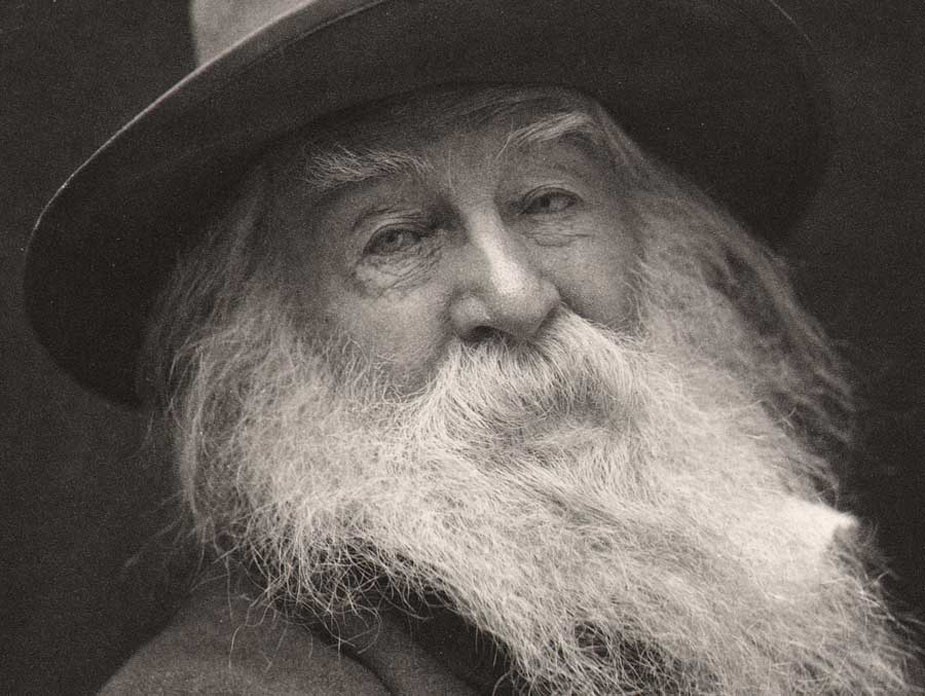 Detail: 1887: Walt Whitman-1819-1892 by George C. Cox: (portrait known as the "Laughing Philosopher") 23.9 x 18.8 cm | 45.2 x 33.3 cm: vintage large format, hand-pulled photogravure printed circa 1905-10 by the Photographische Gesellschaft in Berlin on Van Gelder Zonen plate paper. From: PhotoSeed Archive
Detail: 1887: Walt Whitman-1819-1892 by George C. Cox: (portrait known as the "Laughing Philosopher") 23.9 x 18.8 cm | 45.2 x 33.3 cm: vintage large format, hand-pulled photogravure printed circa 1905-10 by the Photographische Gesellschaft in Berlin on Van Gelder Zonen plate paper. From: PhotoSeed Archive
But unlike the aforementioned staid portraits, which always show him wearing a shirt or jacket- this profile view was unusual for the time in which it was made- 1910-bare-shouldered, and thus sans shirt. When I finally made out the signature of the person this particular print was dedicated to-personally inscribed by the sitter on the print surface recto to someone named “Wiksell” in the upper left corner, it all came together. For on the inside cover of the folder in which this portrait appears (when purchased it was framed) Traubel has inscribed several lines- a love poem, if you will, confirming the sellers hunch, “For Percival Wiksell- 1910” :
You don’t know me? I do not wonder: I dont know myself: I am at a loss about myself:
You ask: who are you? and I shake my head : I look at you and say nothing:
I come to you but I could not tell why: I have something for you but I could not tell what:
Out of me some flower will blossom out of my seedthrow some harvest will come. - Horace Traubel
(From Optimos: “I Just Give You What I’ve Got”- 1910)
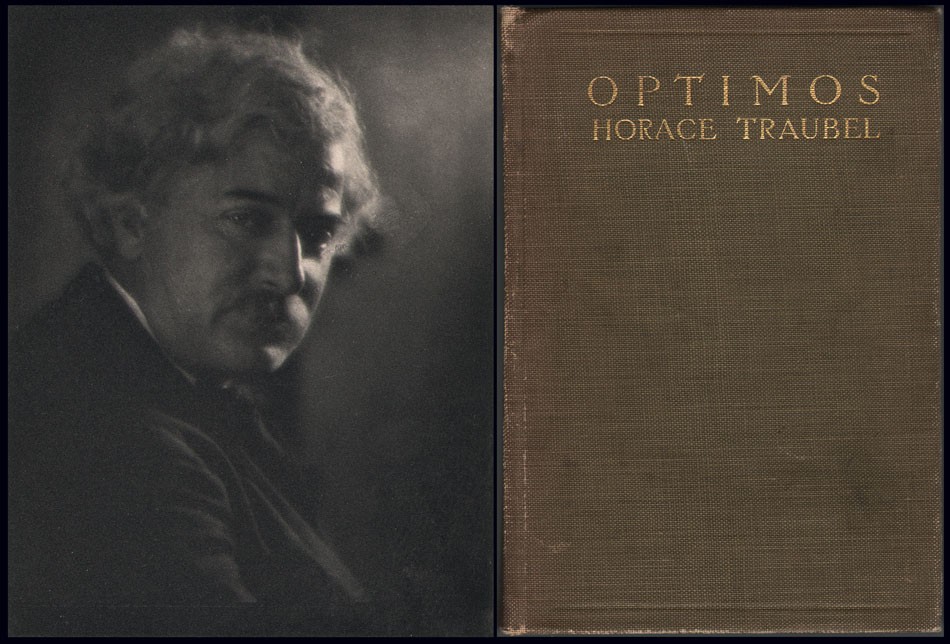 Left: “Frontispiece Portrait of Horace Traubel” (1909) from the book of poetry “Optimos”: Clarence H. White, American: 1910: photogravure: 11.4 x 8.7 | 18.7 x 12.5 cm. From scholar Anne McCauley’s 2017 volume “Clarence H. White and His World: the Art and Craft of Photography, 1895-1925 we learn” : “Reynold’s (Stephen Marion Reynolds (1854-1930) a lawyer who joined the Social Democratic Party in 1900-ed) and Traubel’s recognition of photography as a powerful tool in the class struggle, whether in the form of the dissemination of the fine arts or as a creative means of personal expression if transformed by hand manipulation, caused them to appreciate White’s skills as well as his openness to their political opinions.” (p. 178) Right: Front Cover of “Optimos”, the best-known volume of poetry by Horace Traubel: New York: 1910: B.W. Huebsch (8vo | olive green cloth) From the Walt Whitman Archive online resource, “His own books can be read as socialist refigurings of Whitman's work, each of his titles subtly adjusting Whitman's terminology: …Optimos (1910) redefined Whitman's "kosmos" as an optimized "cheerful whole" (qtd. in Bain 39). And although some in his day declared Traubel as a poet to be Whitman’s successor, there were plenty of critics. Writing in the pages of The Smart Set for July, 1911 under the heading “Novels for Hot Afternoons”, American critic H.L. Mencken, said of “Optimos”: “Horace Traubel fills the three hundred and more pages of his "optimos" (Huebsch) with dishwatery imitations of Walt Whitman, around whom Horace, in Walt's Camden days, revolved as an humble satellite. All of the faults of the master appear in the disciple. There is the same maudlin affection for the hewer of wood and drawer of water, the same frenzy for repeating banal ideas ad nauseam, the same inability to distinguish between a poem and a stump speech. Old Walt, for all his absurdities, was yet a poet at heart. Whenever he ceased, even for a brief moment, to emit his ethical and sociological rubbish, a strange beauty crept into his lines and his own deep emotion glorified them. But not so with Horace. His strophes have little more poetry in them than so many college yells, and the philosophy they voice is almost as bad as the English in which they are written.” From: PhotoSeed Archive
Left: “Frontispiece Portrait of Horace Traubel” (1909) from the book of poetry “Optimos”: Clarence H. White, American: 1910: photogravure: 11.4 x 8.7 | 18.7 x 12.5 cm. From scholar Anne McCauley’s 2017 volume “Clarence H. White and His World: the Art and Craft of Photography, 1895-1925 we learn” : “Reynold’s (Stephen Marion Reynolds (1854-1930) a lawyer who joined the Social Democratic Party in 1900-ed) and Traubel’s recognition of photography as a powerful tool in the class struggle, whether in the form of the dissemination of the fine arts or as a creative means of personal expression if transformed by hand manipulation, caused them to appreciate White’s skills as well as his openness to their political opinions.” (p. 178) Right: Front Cover of “Optimos”, the best-known volume of poetry by Horace Traubel: New York: 1910: B.W. Huebsch (8vo | olive green cloth) From the Walt Whitman Archive online resource, “His own books can be read as socialist refigurings of Whitman's work, each of his titles subtly adjusting Whitman's terminology: …Optimos (1910) redefined Whitman's "kosmos" as an optimized "cheerful whole" (qtd. in Bain 39). And although some in his day declared Traubel as a poet to be Whitman’s successor, there were plenty of critics. Writing in the pages of The Smart Set for July, 1911 under the heading “Novels for Hot Afternoons”, American critic H.L. Mencken, said of “Optimos”: “Horace Traubel fills the three hundred and more pages of his "optimos" (Huebsch) with dishwatery imitations of Walt Whitman, around whom Horace, in Walt's Camden days, revolved as an humble satellite. All of the faults of the master appear in the disciple. There is the same maudlin affection for the hewer of wood and drawer of water, the same frenzy for repeating banal ideas ad nauseam, the same inability to distinguish between a poem and a stump speech. Old Walt, for all his absurdities, was yet a poet at heart. Whenever he ceased, even for a brief moment, to emit his ethical and sociological rubbish, a strange beauty crept into his lines and his own deep emotion glorified them. But not so with Horace. His strophes have little more poetry in them than so many college yells, and the philosophy they voice is almost as bad as the English in which they are written.” From: PhotoSeed Archive
The recipient, Gustave Percival Wiksell, (1863-1940) was a Boston dentist who served as president of the Walt Whitman Fellowship from 1903-1919. So devoted was this disciple to the master that he went to the length of replicating the now famous pose Whitman took from a now lost 1854 daguerreotype by Gabriel Harrison made into an engraving and used as the frontispiece illustration for the 1855 & 1856 editions of Whitman’s masterpiece Leaves of Grass.
Wiksell’s papers are now in the Library of Congress in Washington and he was known to have eulogized Horace Traubell at his funeral in 1919. More than one Traubel scholar lays out the evidence that Wiksell and he were more than good friends, but I will leave that for your own further inquiries. (further attribution can be found in a cutline with this post)
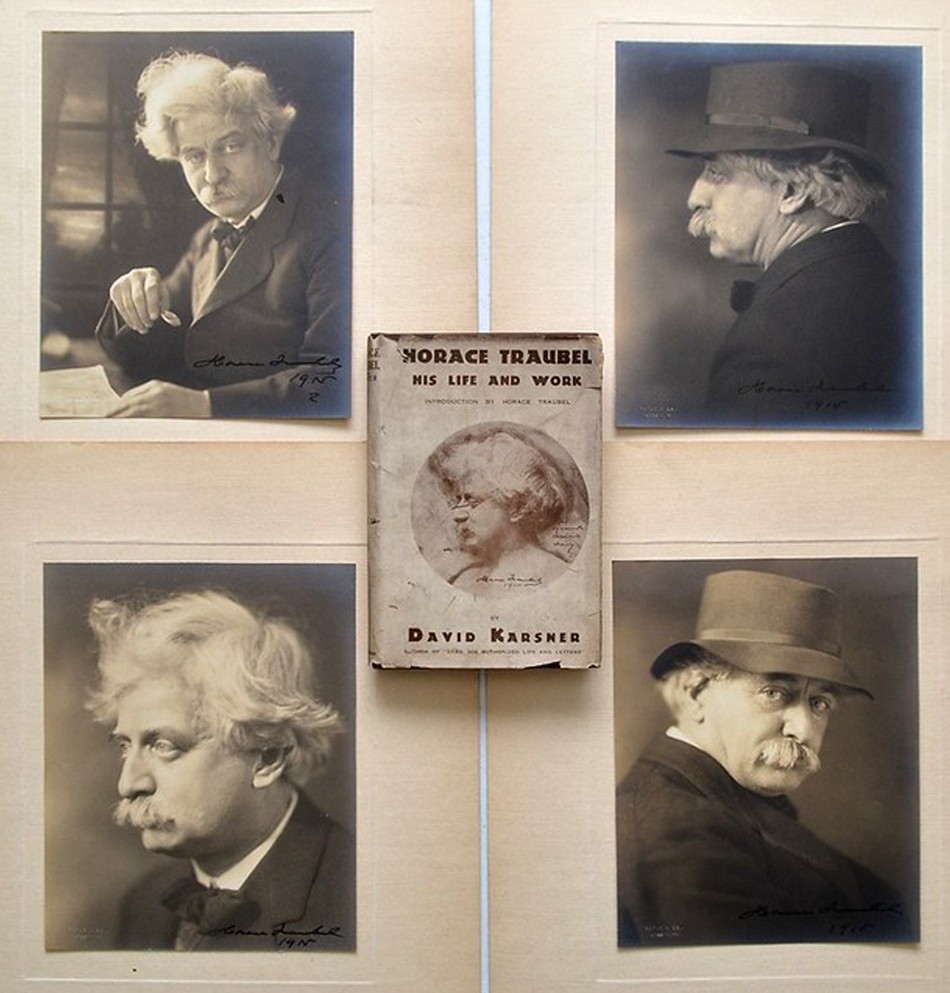 “Ca. 1915 signed and mounted portraits of Horace Traubel” (unknown photographer) surrounding at center: “Horace Traubel: His Life And Work” by David Karsner (New York: Egmont Arens, 1919) with elusive dust-jacket reproducing bare-shouldered 1910 portrait “Horace Traubel: Roundel Portrait”. Commentary on Traubel by Karsner appeared in the online resource Poetrybay in the Fall of 2009: “On the other hand David Karsner, Traubel's biographer… called him “a poet and prophet of the new democracy.” Traubel, suggests Karsner, is part Karl Marx and part Jesus of Nazareth, and in possession of a point of view which issues a labor-conscious ‘warning and challenge.” From Wikipedia: David Fulton "Dave" Karsner (1889–1941) was an American journalist, writer, and socialist political activist. Karsner is best remembered as a key member of the editorial staff of the New York Call and as an early biographer of Socialist Party of America leader Eugene V. Debs. Photographic grouping courtesy The Library of William F. Gable Auction: Savo Auctioneers, Archbald, PA: January 3, 2015.
“Ca. 1915 signed and mounted portraits of Horace Traubel” (unknown photographer) surrounding at center: “Horace Traubel: His Life And Work” by David Karsner (New York: Egmont Arens, 1919) with elusive dust-jacket reproducing bare-shouldered 1910 portrait “Horace Traubel: Roundel Portrait”. Commentary on Traubel by Karsner appeared in the online resource Poetrybay in the Fall of 2009: “On the other hand David Karsner, Traubel's biographer… called him “a poet and prophet of the new democracy.” Traubel, suggests Karsner, is part Karl Marx and part Jesus of Nazareth, and in possession of a point of view which issues a labor-conscious ‘warning and challenge.” From Wikipedia: David Fulton "Dave" Karsner (1889–1941) was an American journalist, writer, and socialist political activist. Karsner is best remembered as a key member of the editorial staff of the New York Call and as an early biographer of Socialist Party of America leader Eugene V. Debs. Photographic grouping courtesy The Library of William F. Gable Auction: Savo Auctioneers, Archbald, PA: January 3, 2015.
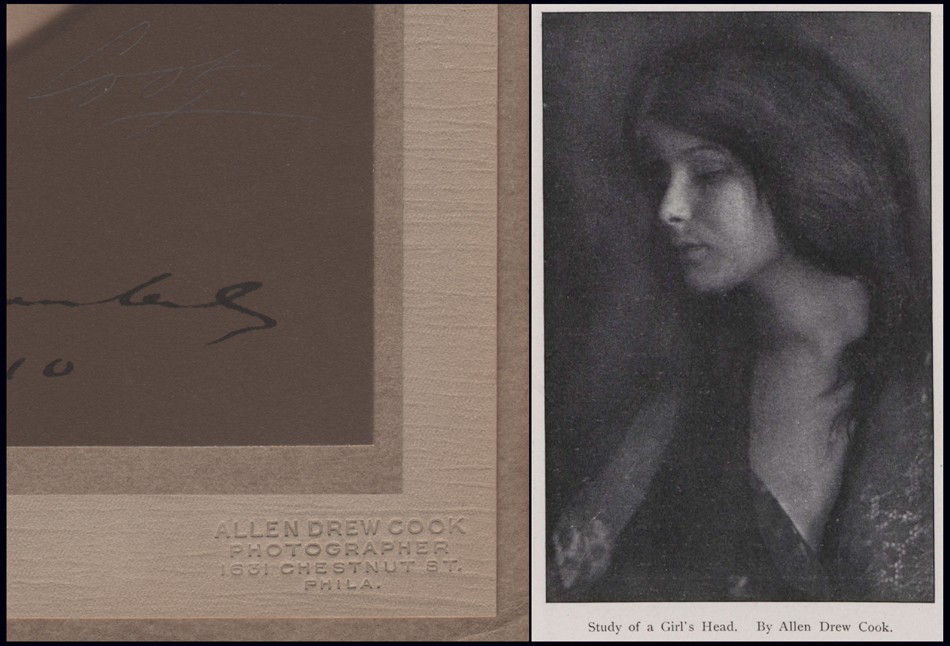 Left: Detail showing blind-stamp for photographer Allen Drew Cook on secondary mount to photograph “Horace Traubel: Roundel Portrait”: Allen Drew Cook, American (1871-1923): 1910: mounted platinum print contained within folder: 17.4” roundel on paper 23.7 x 19.6 cm; supports: 24.8 x 20.6 | 28.4 x 23.9 cm. In upper left of detail is seen graphite signature: “Cook”, underlined outside lower margin of roundel; the blind-stamp additionally lists his address as 1631 Chestnut St. in Philadelphia- the same as for the offices of the The Conservator, a monthly literary magazine edited and published by Horace Traubel beginning in October, 1910. (the magazine, which was started in 1890, previously lists its’ address as 1624 Walnut St. in Philadelphia.) Beginning In 1915 and running into 1916, an advertisement for “Photographic Portraits” by Allen Drew Cook of Eugene Debs, Clarence Darrow, J. William Lloyd and Traubel appeared on the back page of The Conservator. From: PhotoSeed Archive. Right: “Study of a Girl’s Head”, from around 1900, is an early example of a pictorialist photographic portrait entered by Cook in the Third Annual Philadelphia Photographic Salon and reproduced as a halftone in the Salon’s 1900 catalogue. Courtesy: Thomas J. Watson Library Digital Collections - The Metropolitan Museum of Art, New York.
Left: Detail showing blind-stamp for photographer Allen Drew Cook on secondary mount to photograph “Horace Traubel: Roundel Portrait”: Allen Drew Cook, American (1871-1923): 1910: mounted platinum print contained within folder: 17.4” roundel on paper 23.7 x 19.6 cm; supports: 24.8 x 20.6 | 28.4 x 23.9 cm. In upper left of detail is seen graphite signature: “Cook”, underlined outside lower margin of roundel; the blind-stamp additionally lists his address as 1631 Chestnut St. in Philadelphia- the same as for the offices of the The Conservator, a monthly literary magazine edited and published by Horace Traubel beginning in October, 1910. (the magazine, which was started in 1890, previously lists its’ address as 1624 Walnut St. in Philadelphia.) Beginning In 1915 and running into 1916, an advertisement for “Photographic Portraits” by Allen Drew Cook of Eugene Debs, Clarence Darrow, J. William Lloyd and Traubel appeared on the back page of The Conservator. From: PhotoSeed Archive. Right: “Study of a Girl’s Head”, from around 1900, is an early example of a pictorialist photographic portrait entered by Cook in the Third Annual Philadelphia Photographic Salon and reproduced as a halftone in the Salon’s 1900 catalogue. Courtesy: Thomas J. Watson Library Digital Collections - The Metropolitan Museum of Art, New York.
Five years ago on July 4th, America’s birthday, I published a post featuring several vintage likenesses of Walt Whitman- “Oh Say Can you See?” and his importance to capturing the enduring spirit of our country. In this, Traubel certainly will never be magically rediscovered as the good gray poet’s literary successor (none other than H.L. Mencken derided his poetry as “dishwatery imitations of Walt Whitman, around whom Horace, in Walt’s Camden days, revolved as an humble satellite.”) (3.) But his ideals as one spreading love as written in the lines at the top of this post-a socialist ideal in the vein of Whitman- are surely honorable and needed in the fractured American present. Instead of cleaved partisan camps and tribes seemingly taking over our national conversation, how about a bit more love comrades? Socialism has nothing to do with that last word, by the way. Instead, let’s celebrate the ideals of our national melting pot, and give all her citizenry power to the truth of her motto: “E Pluribus Unum” - Out of Many, One.
Just what Horace would have wanted.
Notes:
1. Excerpt: The Guardian (online): Julianne McShane: “Walt Whitman: celebrating an extraordinary life in his bicentennial”: June 12, 2019. One hundred thirty photographic portraits of Walt Whitman have been identified to date.
2. Excerpt: Online resource Poetrybay: Fall, 2009: commentary on Traubel by Karsner.
3. Excerpt: Review: “Optimos” : “Novels for Hot Afternoons”: H.L. Mencken: The Smart Set: July, 1911.
A Day for Rainbows
Posted July 2019 in Documentary Photography, New Additions, Unknown Photographers
A Happy Fourth of July to All!
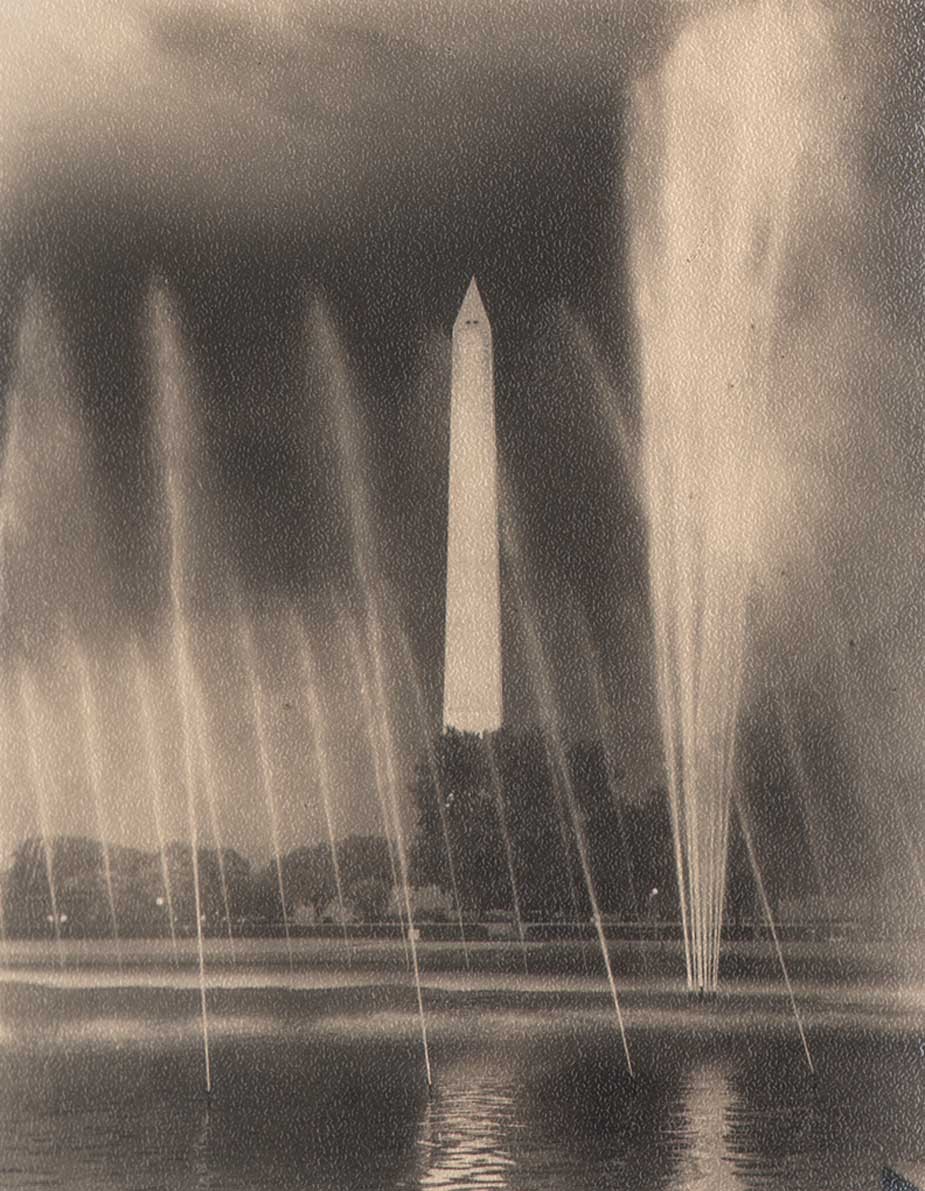 “Rainbow Pool Fountain & Washington Monument”(Washington, D.C.) : ca. 1925-30: Unknown Brooklyn photographer: vintage gelatin silver print: 11.4 x 8.9 cm | 17.7 x 12.6 cm. Designed by landscape architect Frederick Law Olmsted, Jr., “the fountain for this pool was designated the “Rainbow Fountain” in October 1924, when during a trial run just before its dedication a rainbow formed above the fountain’s spray. Operating with 124 nozzles arranged in an elliptical pattern near the outer edge of the pool, and with two clusters of nine north and south of the center, the fountain made a “hazy vista”. (source: National Park Service: Cultural Landscape Report-Lincoln Memorial Grounds-undated pdf document-p. 35) Originally situated between the Lincoln Memorial Reflecting Pool (to the west), and 17th Street NW, (to the east) the fountain and reflecting pool was integrated into the National World War II Memorial in 2001. With the original source negative for this photograph taken in daylight, the photographer has manipulated the image-darkening the sky to make the fountain jets stand out against the backdrop of the Washington Monument. From: PhotoSeed Archive
“Rainbow Pool Fountain & Washington Monument”(Washington, D.C.) : ca. 1925-30: Unknown Brooklyn photographer: vintage gelatin silver print: 11.4 x 8.9 cm | 17.7 x 12.6 cm. Designed by landscape architect Frederick Law Olmsted, Jr., “the fountain for this pool was designated the “Rainbow Fountain” in October 1924, when during a trial run just before its dedication a rainbow formed above the fountain’s spray. Operating with 124 nozzles arranged in an elliptical pattern near the outer edge of the pool, and with two clusters of nine north and south of the center, the fountain made a “hazy vista”. (source: National Park Service: Cultural Landscape Report-Lincoln Memorial Grounds-undated pdf document-p. 35) Originally situated between the Lincoln Memorial Reflecting Pool (to the west), and 17th Street NW, (to the east) the fountain and reflecting pool was integrated into the National World War II Memorial in 2001. With the original source negative for this photograph taken in daylight, the photographer has manipulated the image-darkening the sky to make the fountain jets stand out against the backdrop of the Washington Monument. From: PhotoSeed ArchiveSummer Streams Wide & Small
Posted June 2019 in Alternate Processes, Childhood Photography, Color Photography, Documentary Photography, Journals, New Additions, Painters|Photographers, Scientific Photography, Significant Photographers, Significant Photographs, Unknown Photographers
Herein a summer interlude, if you will, of still, trickling and gushing streams from years past. And if they inspire and beckon for the present, find your own peace or wonderment in the mountains, valleys or pastures of summer wherever your own stream flows.
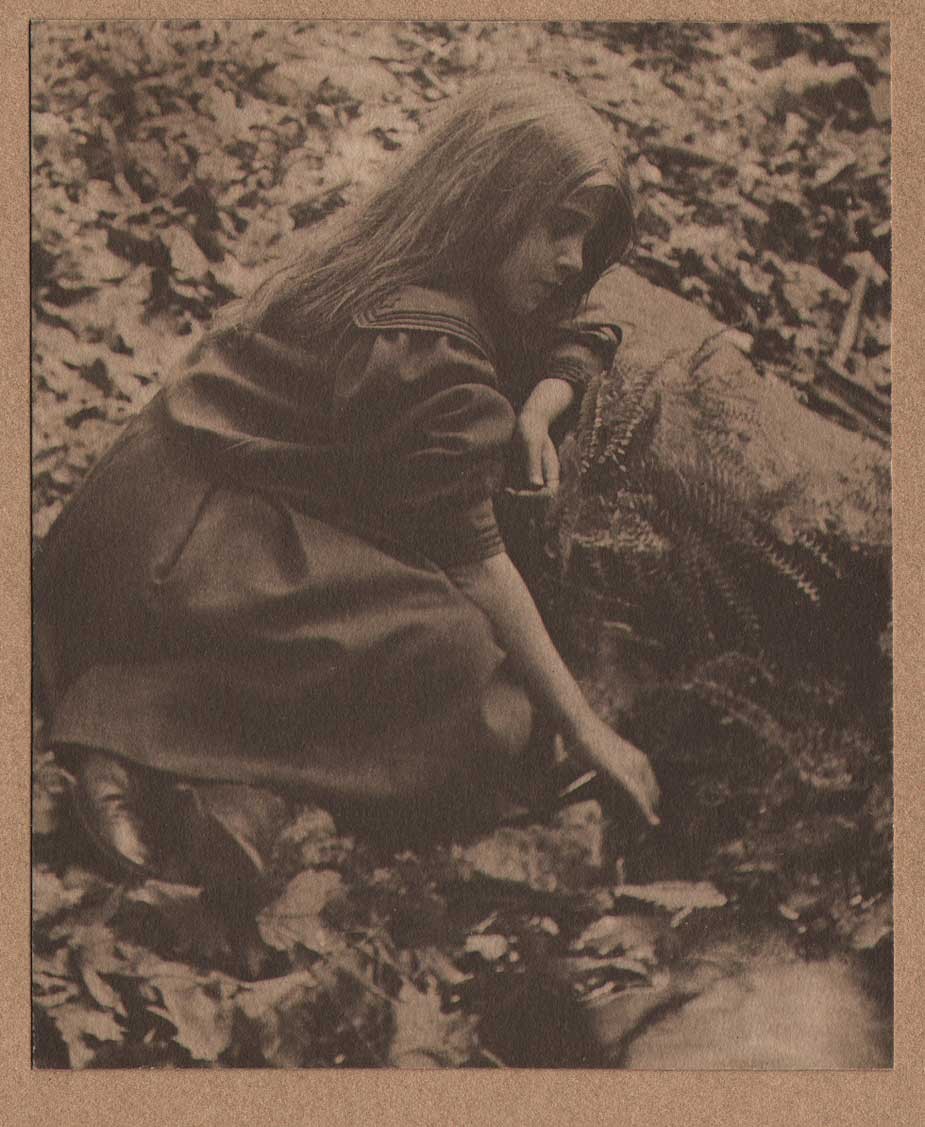 “Dorothy Tucker Gathering Ferns”: Charles Rollins Tucker, American (b. 1868): ca. 1910: mounted brown-toned platinum print: 9.4 x 7.7 cm | 31.2 x 16.0 cm. Born in August, 1899, Dorothy Tucker, a constant photographic subject for her father, then a high school physics teacher at Curtis High School on Staten Island, New York state, holds a spray of freshly-picked ferns while investigating the edge of a stream in the woods. From: PhotoSeed Archive
“Dorothy Tucker Gathering Ferns”: Charles Rollins Tucker, American (b. 1868): ca. 1910: mounted brown-toned platinum print: 9.4 x 7.7 cm | 31.2 x 16.0 cm. Born in August, 1899, Dorothy Tucker, a constant photographic subject for her father, then a high school physics teacher at Curtis High School on Staten Island, New York state, holds a spray of freshly-picked ferns while investigating the edge of a stream in the woods. From: PhotoSeed Archive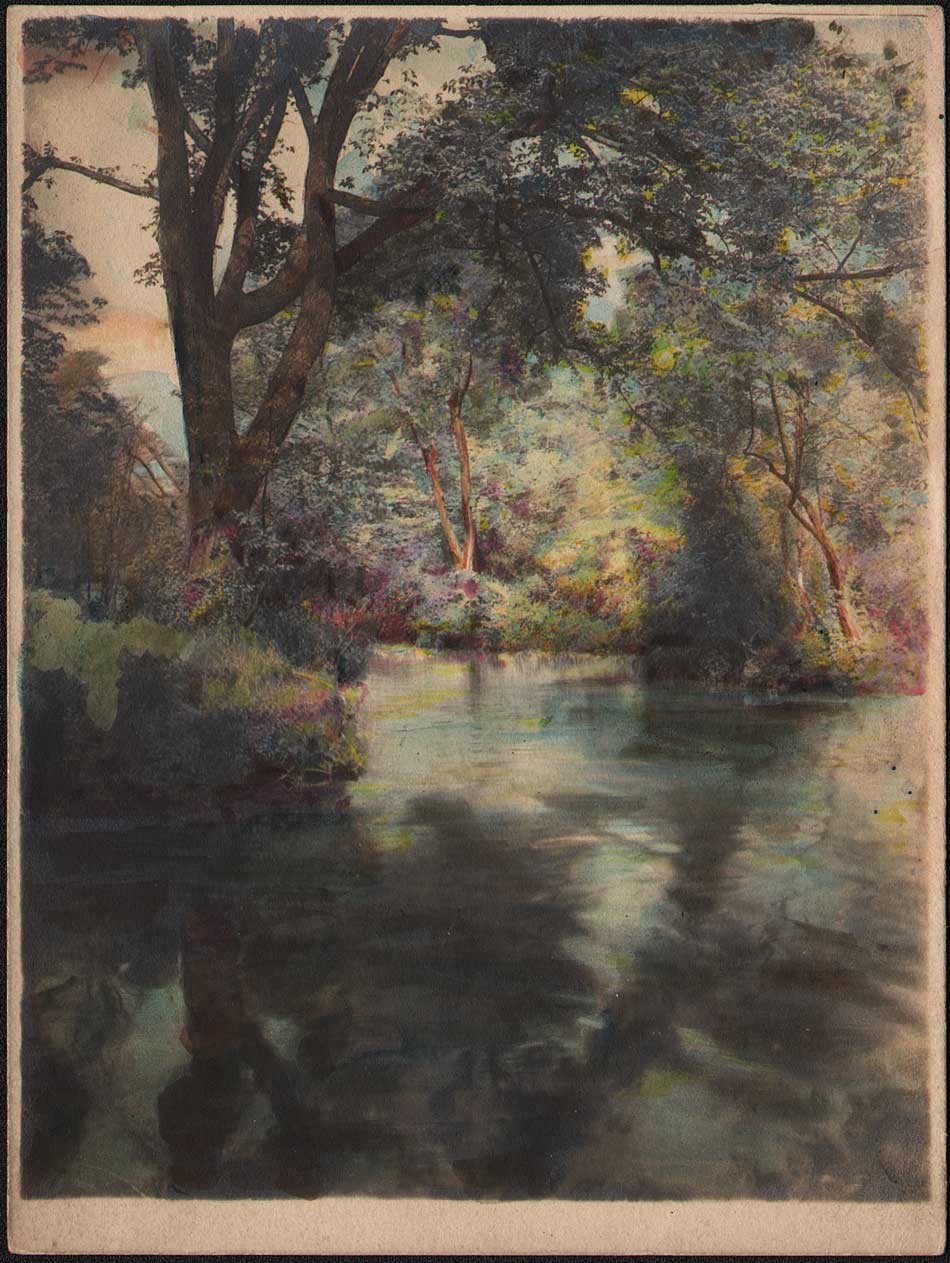 “Stream or Pond at Prospect Park"(Brooklyn, New York): ca. 1910-20: Unknown Brooklyn photographer: hand-colored gelatin silver print: 11.7 x 8.9 cm | 12.4 x 9.3 cm: From: PhotoSeed Archive
“Stream or Pond at Prospect Park"(Brooklyn, New York): ca. 1910-20: Unknown Brooklyn photographer: hand-colored gelatin silver print: 11.7 x 8.9 cm | 12.4 x 9.3 cm: From: PhotoSeed Archive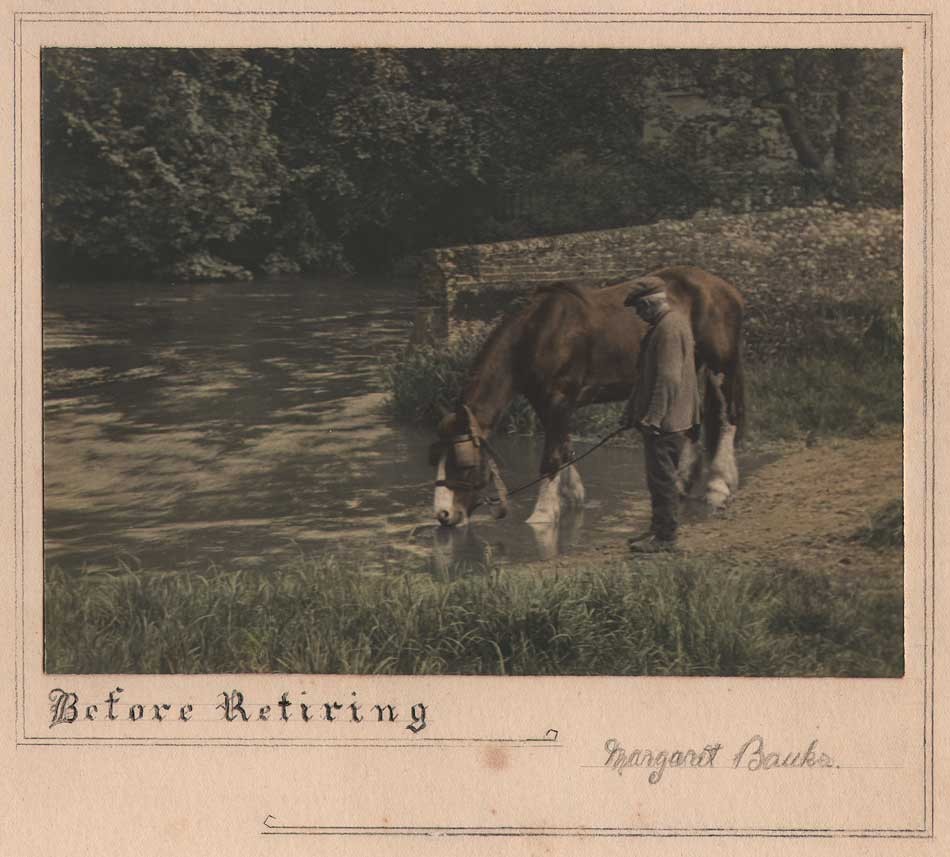 “Before Retiring”: ca. 1910-20: Margaret Bauks, British- (possibly Margaret Florence Bauks: b. 1872?) : hand-colored gelatin silver print: 11.6 x 15.9 cm | 27.8 x 22.8 cm: From: PhotoSeed Archive
“Before Retiring”: ca. 1910-20: Margaret Bauks, British- (possibly Margaret Florence Bauks: b. 1872?) : hand-colored gelatin silver print: 11.6 x 15.9 cm | 27.8 x 22.8 cm: From: PhotoSeed Archive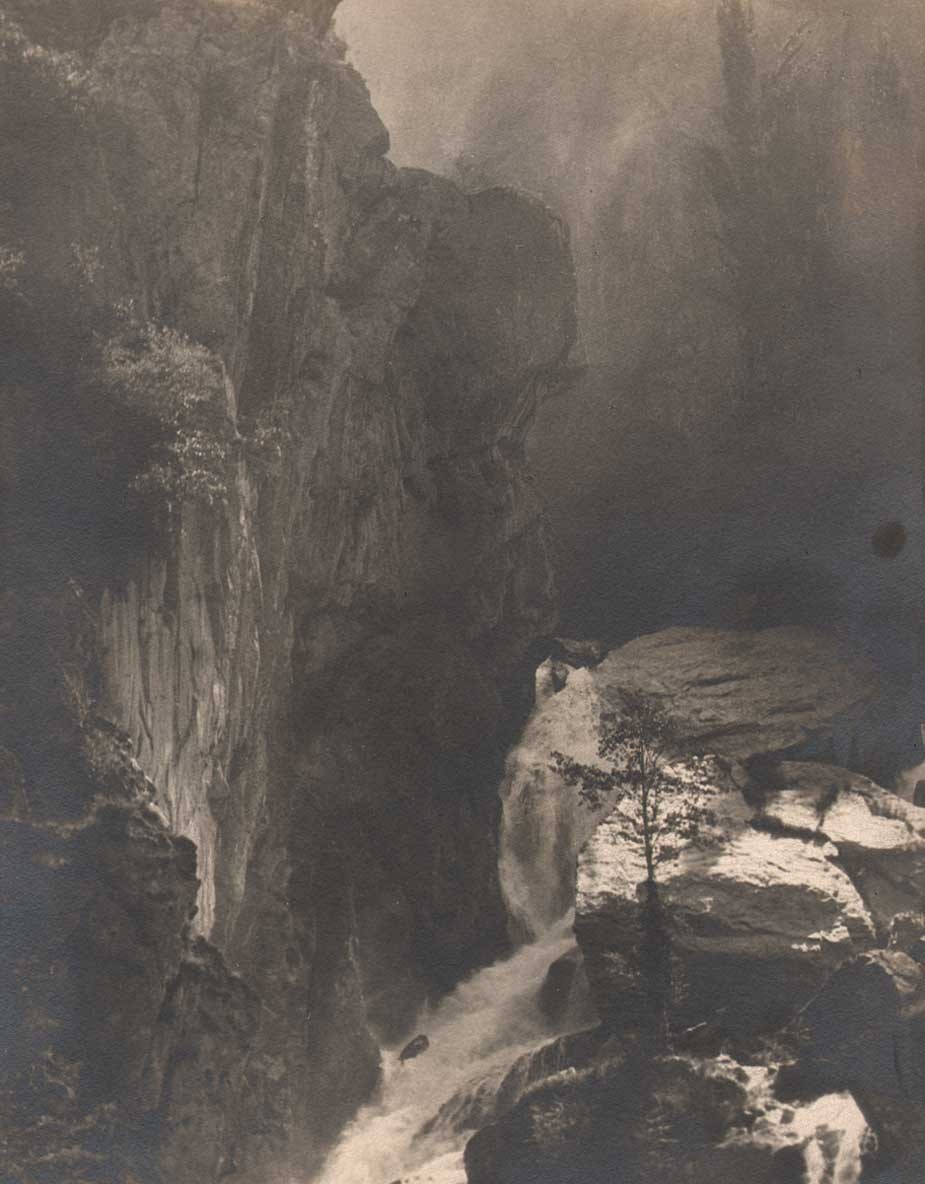 “A Stream of Savoy”: ca. 1927: this print exhibited 1935: Frank Roy Fraprie, American (1874-1951): vintage Bromide print: 24.0 x 18.6 cm | 30.5 x 25.4 cm: As noted in the 1946 American Annual of Photography, (p. 170) Fraprie had been taking photographs in June of 1926 in Eastern France. The area, located in the Haute-Savoie, or Upper Savoy, is a mountainous region of spectacular beauty which includes Lake Annecy, one of France’s largest freshwater lakes. Photographic historian Christian Peterson’s biography of Fraprie gives some background on this important photographer and editor: “Fraprie was the most influential author/publisher of American pictorial photography during the period following the Photo-Secession. From the 1910s to the 1940s, he wrote books and countless articles on all aspects of pictorialism. He edited photographic monthlies and annuals for nearly the entire first half of the twentieth century. In addition, he created his own highly successful pictorial photographs and exhibited them extensively.” From: PhotoSeed Archive
“A Stream of Savoy”: ca. 1927: this print exhibited 1935: Frank Roy Fraprie, American (1874-1951): vintage Bromide print: 24.0 x 18.6 cm | 30.5 x 25.4 cm: As noted in the 1946 American Annual of Photography, (p. 170) Fraprie had been taking photographs in June of 1926 in Eastern France. The area, located in the Haute-Savoie, or Upper Savoy, is a mountainous region of spectacular beauty which includes Lake Annecy, one of France’s largest freshwater lakes. Photographic historian Christian Peterson’s biography of Fraprie gives some background on this important photographer and editor: “Fraprie was the most influential author/publisher of American pictorial photography during the period following the Photo-Secession. From the 1910s to the 1940s, he wrote books and countless articles on all aspects of pictorialism. He edited photographic monthlies and annuals for nearly the entire first half of the twentieth century. In addition, he created his own highly successful pictorial photographs and exhibited them extensively.” From: PhotoSeed Archive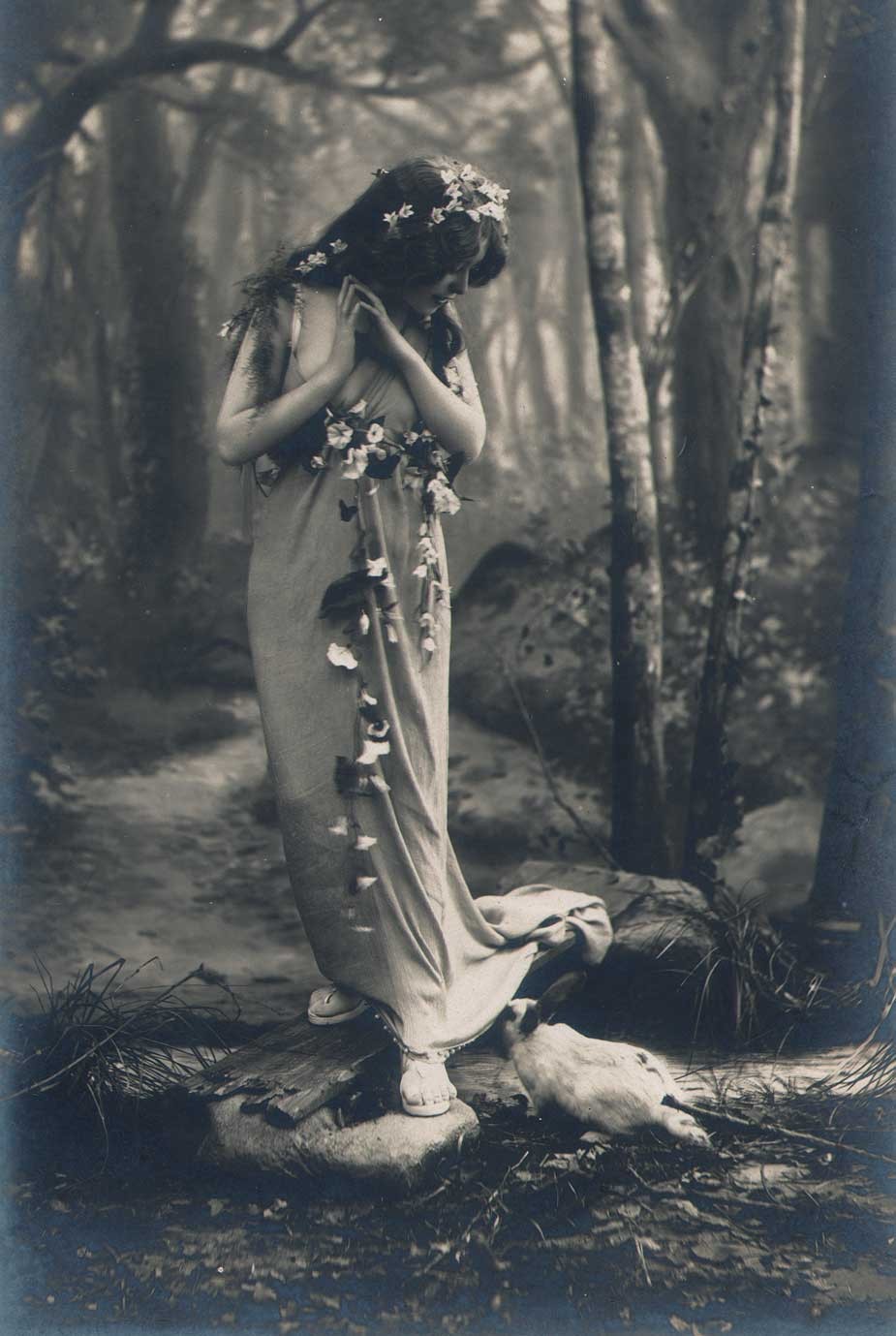 Detail: “Les Fleurs Dans Le Bois” : Léopold-Émile Reutlinger: French (1863-1937): vintage Bromide photograph, ca. 1905. 22.3 x 14.1 | 34.0 x 24.2 cm. Featuring a painted backdrop and wood board placed over a “stream”, this studio photograph features a white rabbit investigating the Belle Epoque era model identified from other variants as “Miss Doll”.(proper identification of this model would be of interest as she has remained a popular subject seen in countless vintage postcards, many hand-tinted) This example was printed by the Milan atelier Maison Tensi and included as a full-page plate in the February, 1905 issue of “La Fotographia Artistica”, a French/Italian photographic journal. From: PhotoSeed Archive
Detail: “Les Fleurs Dans Le Bois” : Léopold-Émile Reutlinger: French (1863-1937): vintage Bromide photograph, ca. 1905. 22.3 x 14.1 | 34.0 x 24.2 cm. Featuring a painted backdrop and wood board placed over a “stream”, this studio photograph features a white rabbit investigating the Belle Epoque era model identified from other variants as “Miss Doll”.(proper identification of this model would be of interest as she has remained a popular subject seen in countless vintage postcards, many hand-tinted) This example was printed by the Milan atelier Maison Tensi and included as a full-page plate in the February, 1905 issue of “La Fotographia Artistica”, a French/Italian photographic journal. From: PhotoSeed Archive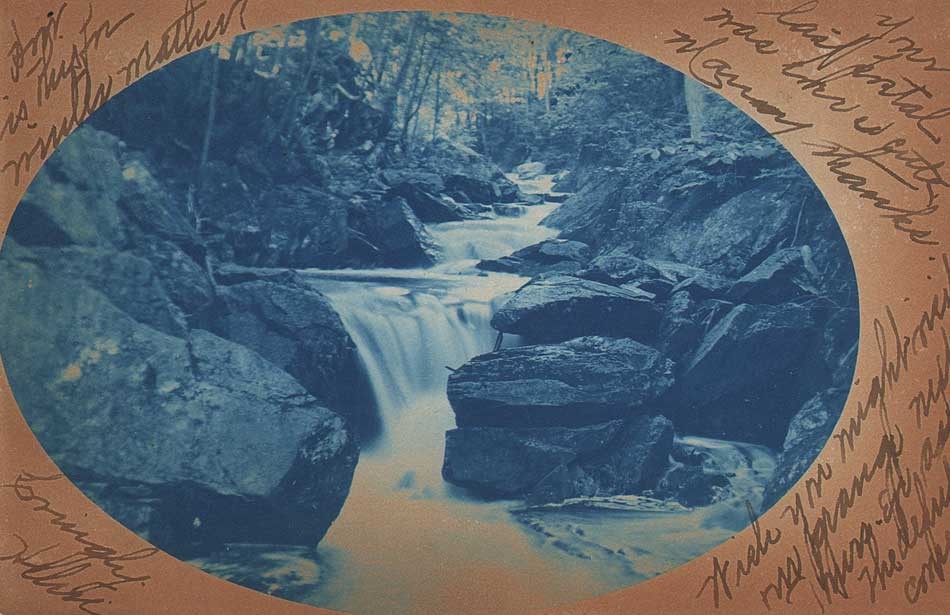 “A Rocky Brook” (New England?) : ca. 1906: Unknown American photographer: vintage cyanotype rppc: 8.9 x 13.8 cm. This idyllic cascading waterfall may depict the Minnewawa Glen in Marlborough, New Hampshire. Signed on the recto: “Lovingly Helen” in the lower left corner, it’s postmarked November 15, 1906 from Marlboro, N.H. addressed to Miss Nettie A. Hastings of East Sullivan, N.H. From: PhotoSeed Archive
“A Rocky Brook” (New England?) : ca. 1906: Unknown American photographer: vintage cyanotype rppc: 8.9 x 13.8 cm. This idyllic cascading waterfall may depict the Minnewawa Glen in Marlborough, New Hampshire. Signed on the recto: “Lovingly Helen” in the lower left corner, it’s postmarked November 15, 1906 from Marlboro, N.H. addressed to Miss Nettie A. Hastings of East Sullivan, N.H. From: PhotoSeed Archive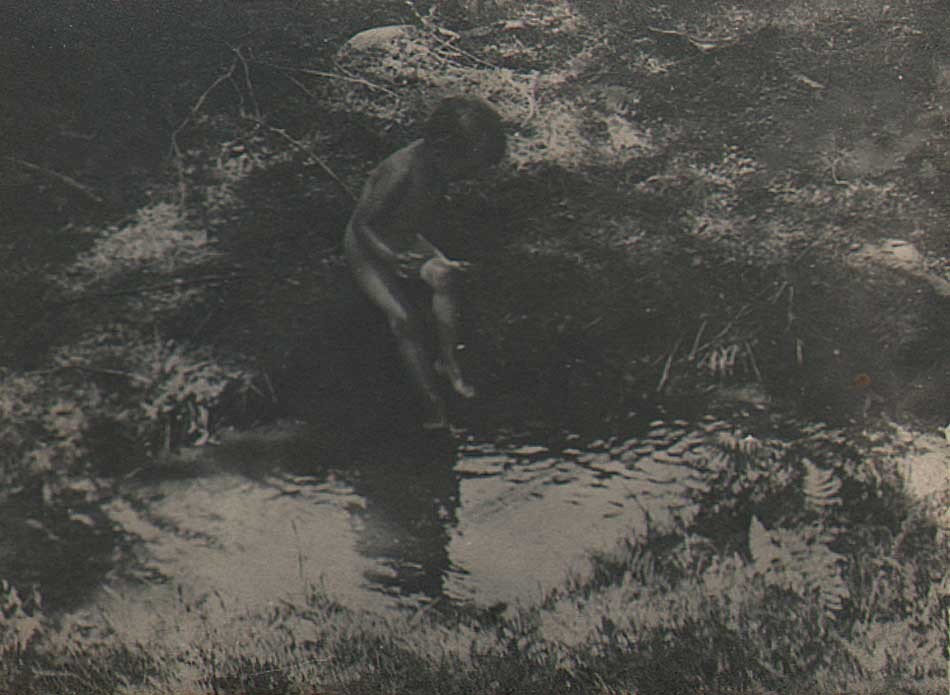 “John Robert Tucker Skinny Dipping”: Charles Rollins Tucker, American (b. 1868): ca. 1915: unmounted platinum print: 3.8 x 5.2 cm. Born in March, 1914, John Robert Tucker, was the second of three children born to the former Mary Carruthers and photographer Charles R. Tucker. Here, the young boy plays in a woodland stream, with the photograph most likely taken in New England. John, according to his 1941 marriage certificate, was an electrical engineer by training. He died in 1991 in La Habra, Orange County, CA. From: PhotoSeed Archive
“John Robert Tucker Skinny Dipping”: Charles Rollins Tucker, American (b. 1868): ca. 1915: unmounted platinum print: 3.8 x 5.2 cm. Born in March, 1914, John Robert Tucker, was the second of three children born to the former Mary Carruthers and photographer Charles R. Tucker. Here, the young boy plays in a woodland stream, with the photograph most likely taken in New England. John, according to his 1941 marriage certificate, was an electrical engineer by training. He died in 1991 in La Habra, Orange County, CA. From: PhotoSeed Archive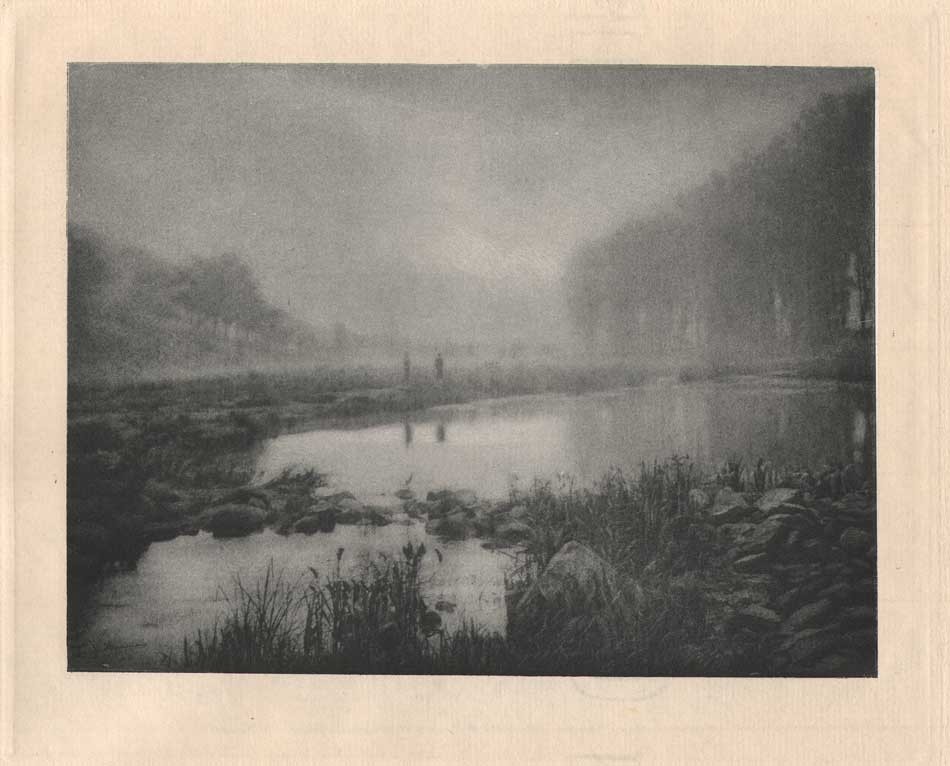 “Brume après la Pluie”: (1906) 1908: Gustave Marissiaux, Belgian (1872-1929) Photogravure on Van Gelder Zonen laid paper: 13.4 x 17.6 | 28.4 x 39.9 cm. Plate XXVI from Marissiaux’s tour-de-force gravure folio “Visions D’Artiste” comprised of 30 plates dating 1899-1908. Translating to “Mist after the Rain”, two figures in the distance stand looking out over an enlarged pond or stream located in "La Terre Wallonne” as identified in the portfolio index: more commonly known today as Wallonia- the southern region of Belgium. From: PhotoSeed Archive
“Brume après la Pluie”: (1906) 1908: Gustave Marissiaux, Belgian (1872-1929) Photogravure on Van Gelder Zonen laid paper: 13.4 x 17.6 | 28.4 x 39.9 cm. Plate XXVI from Marissiaux’s tour-de-force gravure folio “Visions D’Artiste” comprised of 30 plates dating 1899-1908. Translating to “Mist after the Rain”, two figures in the distance stand looking out over an enlarged pond or stream located in "La Terre Wallonne” as identified in the portfolio index: more commonly known today as Wallonia- the southern region of Belgium. From: PhotoSeed Archive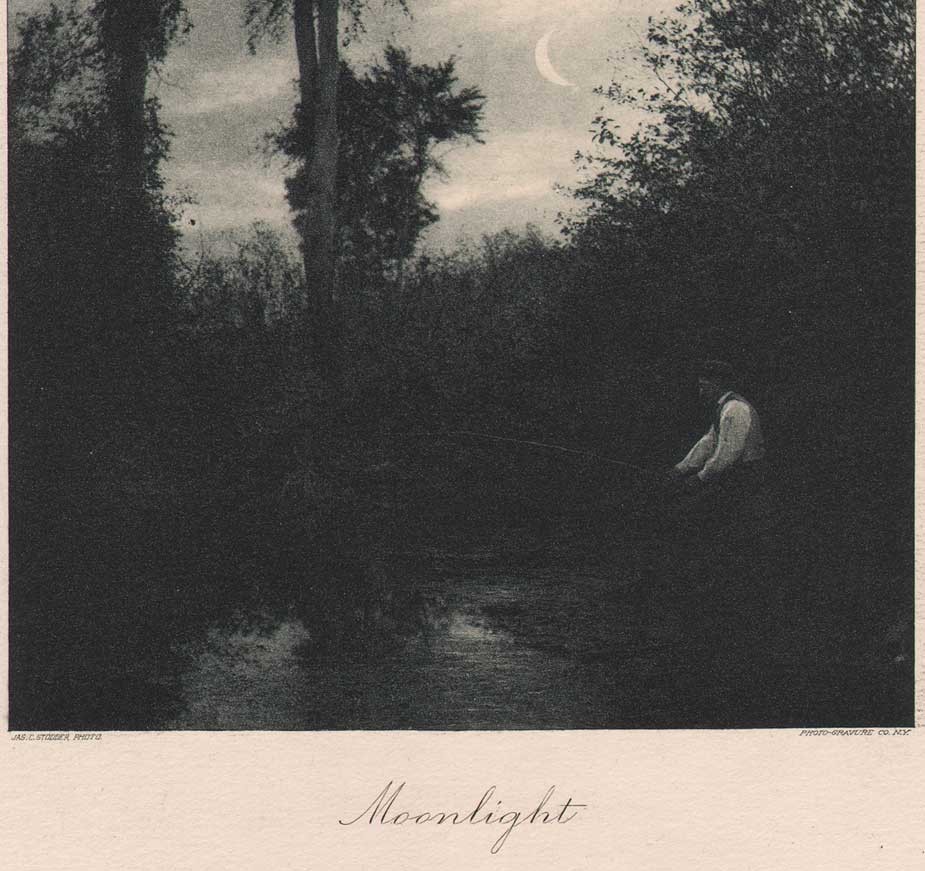 Detail: “Moonlight”: James C. Stodder, American: (1838-1917). 1890. Hand-pulled photogravure published in periodical "Sun & Shade”, New York: November, 1890: whole #27: N.Y. Photogravure Co.: 18.3 x 11.9 | 35.0 x 27.4 cm. A crescent moon rises above a wooded landscape at dusk while a gentleman fishes from the banks of a pond or stream. Stodder graduated from Rensselaer Polytechnic Institute in 1859 and moved to Bangor, Maine, where he first learned the wet-plate process of photography. A lawyer, he was son of a Boston jeweler, (obit) and financially well off. In 1876, he accompanied famed Hudson River School painter Frederic E. Church to the Mount Katahdin region of Maine. From: PhotoSeed Archive
Detail: “Moonlight”: James C. Stodder, American: (1838-1917). 1890. Hand-pulled photogravure published in periodical "Sun & Shade”, New York: November, 1890: whole #27: N.Y. Photogravure Co.: 18.3 x 11.9 | 35.0 x 27.4 cm. A crescent moon rises above a wooded landscape at dusk while a gentleman fishes from the banks of a pond or stream. Stodder graduated from Rensselaer Polytechnic Institute in 1859 and moved to Bangor, Maine, where he first learned the wet-plate process of photography. A lawyer, he was son of a Boston jeweler, (obit) and financially well off. In 1876, he accompanied famed Hudson River School painter Frederic E. Church to the Mount Katahdin region of Maine. From: PhotoSeed Archive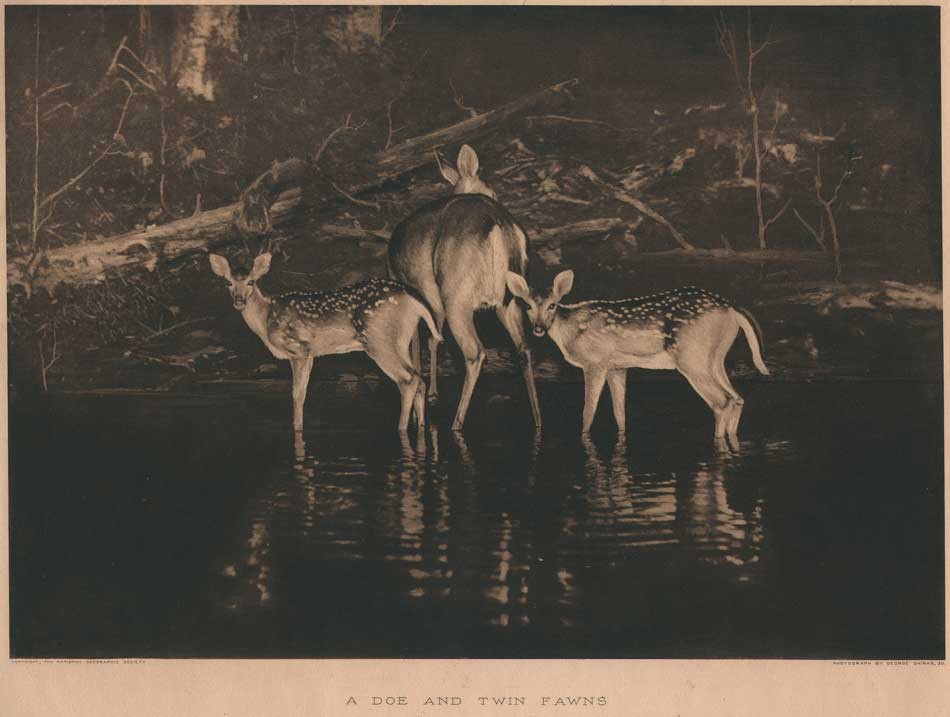 “A Doe and Twin Fawns” (taken 1896) 1916: George Shiras 3rd, American (1859-1942) Vintage photogravure published by the National Geographic Society, Washington, D.C. : 21.2 x 30.3 | 40.5 x 50.8 cm. A pioneer of using flashlight photography to record wildlife in their natural environments at night, Shiras used the method of “Jacklighting”, a form of hunting using a fixed continuous light source mounted in the bow of a canoe to draw the attention of wildlife: in this case three deer, while then utilizing magnesium flash-powder to freeze the scene in-camera. His series of twelve midnight views, including “A Doe and Twin Fawns”-also known as “Innocents Abroad” would earn Shiras international acclaim and many important awards. A one-term Congressman for the state of Michigan, (his father George Shiras Sr. was a former Justice of the U.S. Supreme Court) he was also an important naturalist who helped placed migratory birds and fish under Federal control. (The eventual 1918 Migratory Bird Treaty Act had groundings in legislation Shiras introduced to Congress in 1903 as the first comprehensive migratory bird law not voted on.) For additional background, see article by Matthew Brower in the journal History of Photography, Summer,2008: “George Shiras and the Circulation of Wildlife Photography”. From: PhotoSeed Archive
“A Doe and Twin Fawns” (taken 1896) 1916: George Shiras 3rd, American (1859-1942) Vintage photogravure published by the National Geographic Society, Washington, D.C. : 21.2 x 30.3 | 40.5 x 50.8 cm. A pioneer of using flashlight photography to record wildlife in their natural environments at night, Shiras used the method of “Jacklighting”, a form of hunting using a fixed continuous light source mounted in the bow of a canoe to draw the attention of wildlife: in this case three deer, while then utilizing magnesium flash-powder to freeze the scene in-camera. His series of twelve midnight views, including “A Doe and Twin Fawns”-also known as “Innocents Abroad” would earn Shiras international acclaim and many important awards. A one-term Congressman for the state of Michigan, (his father George Shiras Sr. was a former Justice of the U.S. Supreme Court) he was also an important naturalist who helped placed migratory birds and fish under Federal control. (The eventual 1918 Migratory Bird Treaty Act had groundings in legislation Shiras introduced to Congress in 1903 as the first comprehensive migratory bird law not voted on.) For additional background, see article by Matthew Brower in the journal History of Photography, Summer,2008: “George Shiras and the Circulation of Wildlife Photography”. From: PhotoSeed Archive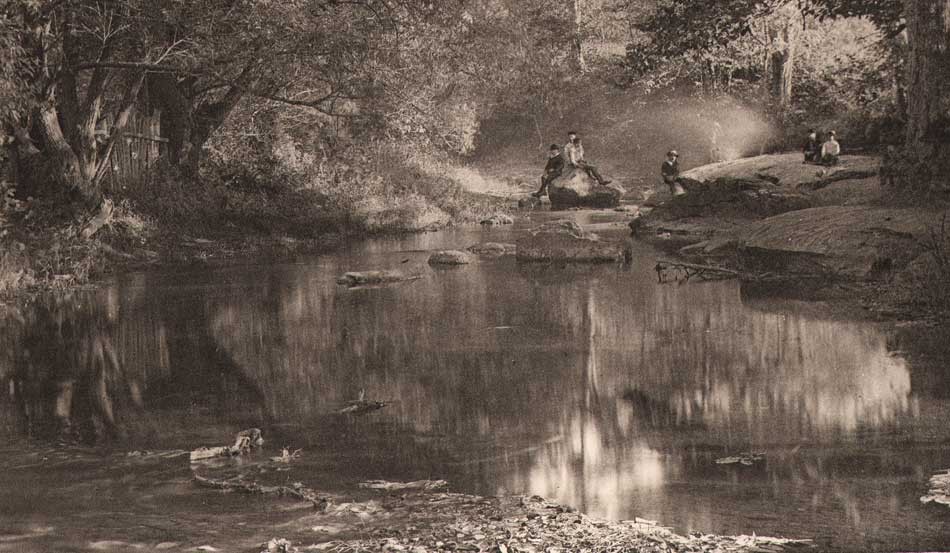 Detail: “A Corn Roast” Oliver Patterson Watts, American: (1865-1953). 1892. Hand-pulled photogravure published in periodical "Sun & Shade”, New York: June, 1892: whole #46: N.Y. Photogravure Co.: 14.7 x 23.2 | 34.6 x 27.4 cm. The index for the issue of Sun & Shade in which this photograph appears states: “Mr. Watts writes us that while wandering with his camera along “The Green,” a favorite picnic ground near Thomastown,(sic) Maine, he came upon this group of boys roasting corn and potatoes. At the sight of the camera they immediately grouped themselves, anxious to be “took.” The negative was made with a Scovill Favorite Camera, Waterbury lens, with an exposure of five seconds on a seed plate. It was developed with Pyro and Sodium Carbonate.” Dr. Oliver Patterson Watts was born in Thomaston, Maine, and graduated from Bowdoin College in 1889. Interestingly, in 1890, Potts and Dr. Julius Stieglitz, the brother of Alfred Stieglitz, were fellow scholars in chemistry at the newly opened Clark University in Worcester, MA. He later entered the University of Wisconsin in 1905 and took charge of the Carnegie Research on Electrolytic Iron under Dr. Charles F. Burgess. According to an Oct. 2009 article on Potts for the online resource Plating & Surface Finishing, the most important of his fifty-nine papers on plating and corrosion is probably “Rapid Nickel Plating,” presented before the Electrochemical Society in 1915. From: PhotoSeed Archive
Detail: “A Corn Roast” Oliver Patterson Watts, American: (1865-1953). 1892. Hand-pulled photogravure published in periodical "Sun & Shade”, New York: June, 1892: whole #46: N.Y. Photogravure Co.: 14.7 x 23.2 | 34.6 x 27.4 cm. The index for the issue of Sun & Shade in which this photograph appears states: “Mr. Watts writes us that while wandering with his camera along “The Green,” a favorite picnic ground near Thomastown,(sic) Maine, he came upon this group of boys roasting corn and potatoes. At the sight of the camera they immediately grouped themselves, anxious to be “took.” The negative was made with a Scovill Favorite Camera, Waterbury lens, with an exposure of five seconds on a seed plate. It was developed with Pyro and Sodium Carbonate.” Dr. Oliver Patterson Watts was born in Thomaston, Maine, and graduated from Bowdoin College in 1889. Interestingly, in 1890, Potts and Dr. Julius Stieglitz, the brother of Alfred Stieglitz, were fellow scholars in chemistry at the newly opened Clark University in Worcester, MA. He later entered the University of Wisconsin in 1905 and took charge of the Carnegie Research on Electrolytic Iron under Dr. Charles F. Burgess. According to an Oct. 2009 article on Potts for the online resource Plating & Surface Finishing, the most important of his fifty-nine papers on plating and corrosion is probably “Rapid Nickel Plating,” presented before the Electrochemical Society in 1915. From: PhotoSeed Archive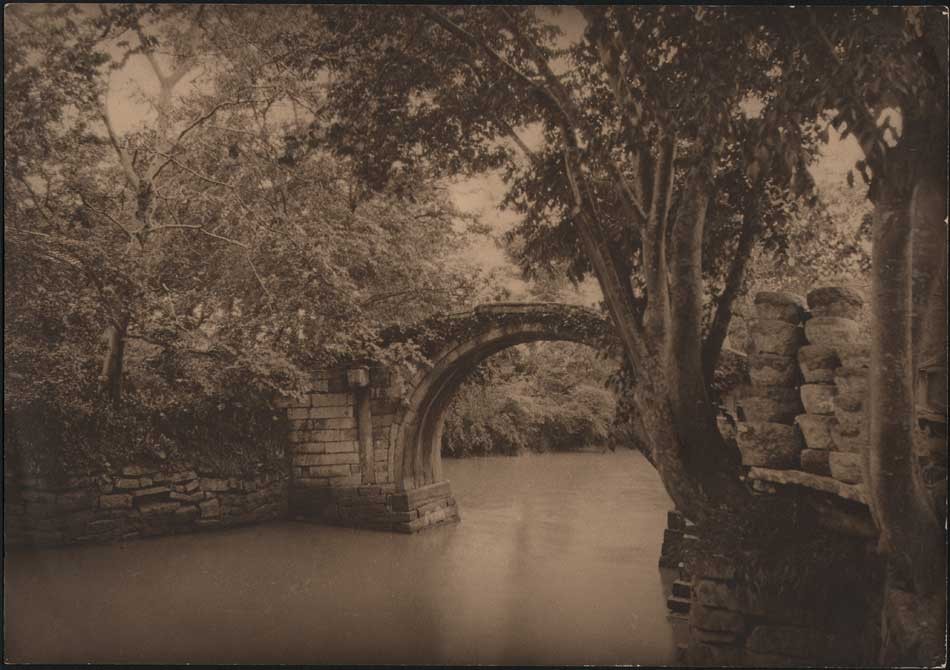 “Mutu Bridge”: Donald Mennie, Scottish (1875-1944) 1922: Vintage unmounted bromide print: 24.2 x 34.6 cm. This picturesque Chinese river scene first appeared as a full-page plate variant in the 1914 volume “My Lady of the Chinese Courtyard” (between pp. 254-5) by author Elizabeth Cooper and then as Plate #7 “Mutu Bridge” in the photographer’s ca. 1914 work “Picturesque China: A Series of Vandyck Photogravures illustrating Chinese Life and Surroundings”. From: PhotoSeed Archive
“Mutu Bridge”: Donald Mennie, Scottish (1875-1944) 1922: Vintage unmounted bromide print: 24.2 x 34.6 cm. This picturesque Chinese river scene first appeared as a full-page plate variant in the 1914 volume “My Lady of the Chinese Courtyard” (between pp. 254-5) by author Elizabeth Cooper and then as Plate #7 “Mutu Bridge” in the photographer’s ca. 1914 work “Picturesque China: A Series of Vandyck Photogravures illustrating Chinese Life and Surroundings”. From: PhotoSeed Archive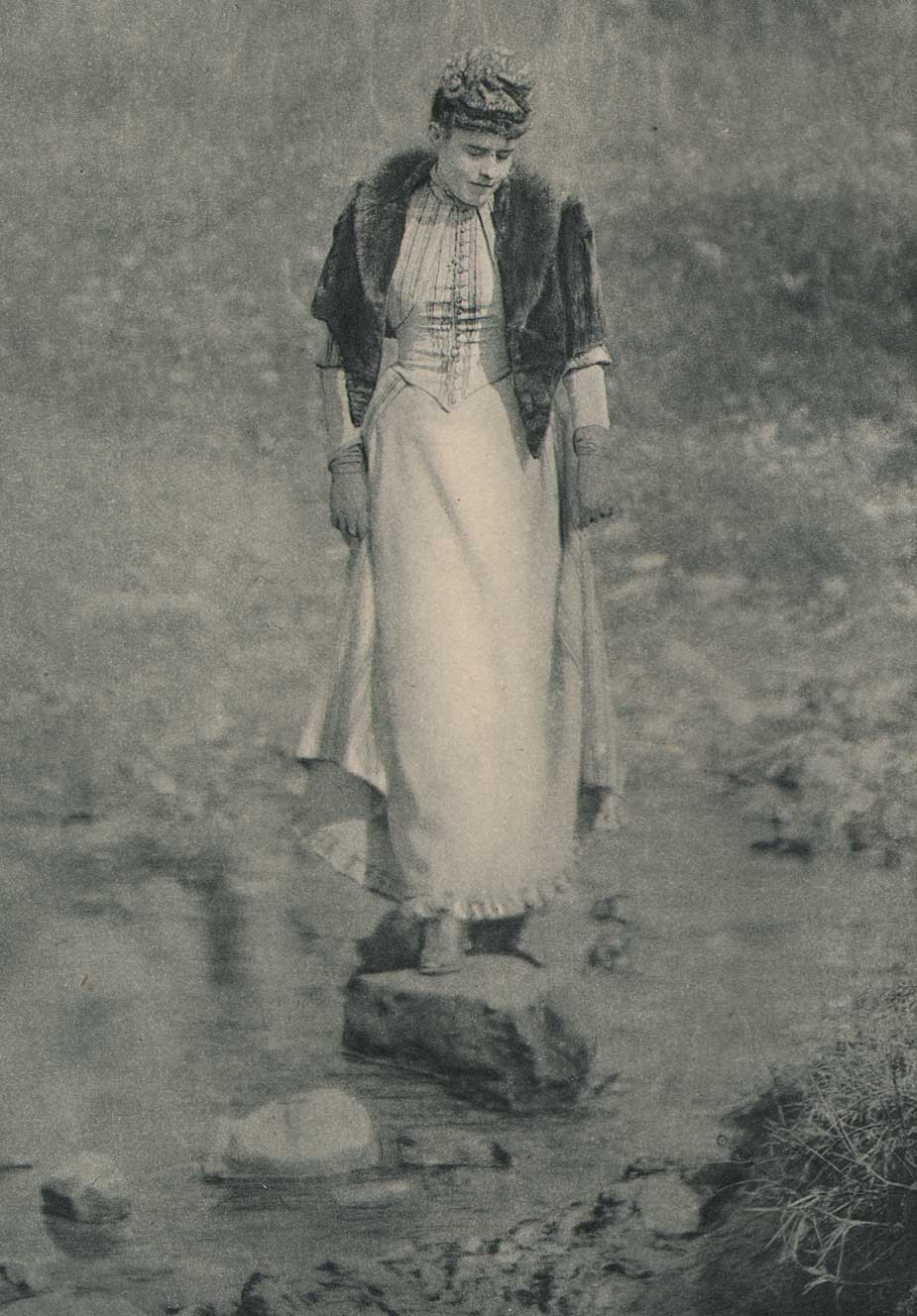 Detail: “Stepping Stones” George Bacon Wood Jr., American: (1832-1909). 1894. Hand-pulled photogravure published in periodical "Sun & Shade”, New York: January, 1894: whole #65: N.Y. Photogravure Co.: 20.5 x 11.7 | 34.9 x 27.5 cm. The index for the issue of Sun & Shade in which this photograph appears states: “To the meditative woman crossing the brook with careful steps upon the projecting stones, Oliver Wendell Holmes’ words, in his “Professor at the Breakfast Table,” can be appropriately applied: “The wisest woman you talk with is ignorant of something that you know, but an elegant woman never forgets her elegance.” With no eye to see her, as she crosses the woodland stream, the figure in the picture appears reposeful, full of thought, and unconsciously elegant in pose. This is a charming photograph from nature, simple, truthful and artistic.” From: PhotoSeed Archive
Detail: “Stepping Stones” George Bacon Wood Jr., American: (1832-1909). 1894. Hand-pulled photogravure published in periodical "Sun & Shade”, New York: January, 1894: whole #65: N.Y. Photogravure Co.: 20.5 x 11.7 | 34.9 x 27.5 cm. The index for the issue of Sun & Shade in which this photograph appears states: “To the meditative woman crossing the brook with careful steps upon the projecting stones, Oliver Wendell Holmes’ words, in his “Professor at the Breakfast Table,” can be appropriately applied: “The wisest woman you talk with is ignorant of something that you know, but an elegant woman never forgets her elegance.” With no eye to see her, as she crosses the woodland stream, the figure in the picture appears reposeful, full of thought, and unconsciously elegant in pose. This is a charming photograph from nature, simple, truthful and artistic.” From: PhotoSeed Archive “Derniers Rayons Dans la Forêt”: Guglielmo Oliaro, Italian: (1874 -1936) vintage Bromide photograph, ca. 1900? 1907: 16.6 x 22.5 | 23.5 x 32.7 cm. Translating to “Last Rays In The Forest”, this bucolic scene at dusk features a rushing stream and footbridge bisecting a a silhouetted line of Pollarded Willow trees. From Turin, amateur photographer Dr. Guglielmo Oliaro was very interested in the arts, founding a medical publishing house that survives to this day: From the InterFairs online resource: “Minerva Medica was the brainchild of a Turin GP (General Practitioner -ed.) Dr. Guglielmo Oliaro, a scientist with a passion for literature, art and music. It was on December 8 1925 that Dr. Oliaro got together with a small group of partners to set up the original company, Tipografia Editrice Minerva based in Turin. The creation of that company was a response to the growing success both in Italy and abroad, of Minerva Medica, a weekly journal for the general practitioner that first came out in 1909. Edizioni Minerva Medica S.p.A. was set up as a limited company by Dr. Guglielmo Oliaro on June 9 1934, for the purpose of supplying the Italian medical profession with text-books and scientific journals.” This example of Oliaro’s work was printed by the Milan atelier Maison Tensi and included as a full-page plate in the April, 1907 issue of “La Fotographia Artistica”, a French/Italian photographic journal. From: PhotoSeed Archive
“Derniers Rayons Dans la Forêt”: Guglielmo Oliaro, Italian: (1874 -1936) vintage Bromide photograph, ca. 1900? 1907: 16.6 x 22.5 | 23.5 x 32.7 cm. Translating to “Last Rays In The Forest”, this bucolic scene at dusk features a rushing stream and footbridge bisecting a a silhouetted line of Pollarded Willow trees. From Turin, amateur photographer Dr. Guglielmo Oliaro was very interested in the arts, founding a medical publishing house that survives to this day: From the InterFairs online resource: “Minerva Medica was the brainchild of a Turin GP (General Practitioner -ed.) Dr. Guglielmo Oliaro, a scientist with a passion for literature, art and music. It was on December 8 1925 that Dr. Oliaro got together with a small group of partners to set up the original company, Tipografia Editrice Minerva based in Turin. The creation of that company was a response to the growing success both in Italy and abroad, of Minerva Medica, a weekly journal for the general practitioner that first came out in 1909. Edizioni Minerva Medica S.p.A. was set up as a limited company by Dr. Guglielmo Oliaro on June 9 1934, for the purpose of supplying the Italian medical profession with text-books and scientific journals.” This example of Oliaro’s work was printed by the Milan atelier Maison Tensi and included as a full-page plate in the April, 1907 issue of “La Fotographia Artistica”, a French/Italian photographic journal. From: PhotoSeed Archive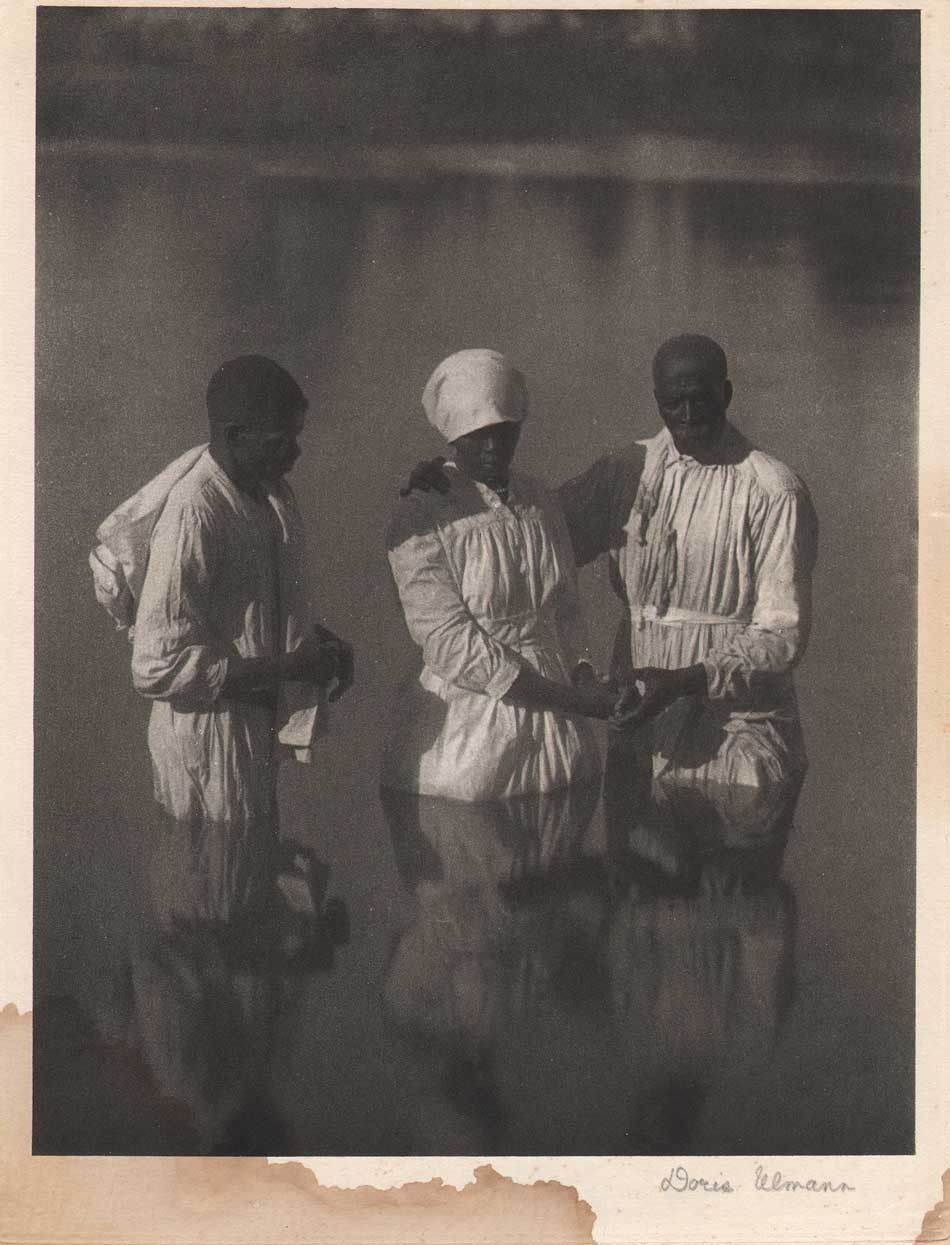 “Baptismal Scene” : Doris Ulmann, American: (1882 –1934) 1933: Signed, hand-pulled photogravure included as additional loose plate from deluxe edition of “Roll, Jordan, Roll”: 21.3 x 16.4 | 28.3 x 20.7 cm. In a rather interesting coincidence, this particular example of a summer stream showing a well-known river baptism by Ulmann has been partially immersed by moisture along the lower margin. From p. 116 of the volume: “A candidate for admission into the church must first be baptized. The Methodists have water sprinkled on their heads, but Baptists must be publicly immersed. These “baptisms” attract large crowds of onlookers. The candidates all arrive at the “pool” dressed in long white robes, which are carefully put away after the ceremony to serve as their shrouds some day. When they are assembled, the preacher and the leader, also dressed in white robes, lead the first candidate down into the water, where he is dipped three times, once in the name of the Father, once in the name of the Son, and once in the name of the Holy Ghost. As he is lead up out of the water, all his sins are left behind, drowned and buried in a watery grave. His soul is cleansed white as snow and he is ready to be received into full church membership. Unless he “falls” into sin and gets “turned out” of the church, he will some day be received into fellowship with God’s holy angels up in heaven.” The following review of Roll, Jordon, Roll comes from Steve Watson and was included on the Amon Carter Museum of American Art website, first published in 2016: Photographer Doris Ulmann came from an affluent white New York City family. She took teacher training with photographer Lewis Hine at the Ethical Culture School and subsequently studied psychology and law at Columbia University. She also studied photography with Clarence H. White, a founding member of the Photo-Secession movement known for teaching the Pictorialist style. Ulmann collaborated with novelist Julia Peterkin on a book project titled Roll, Jordan, Roll(New York: R.O. Ballou, 1933). The book focuses on the lives of former slaves and their descendants on a plantation in the Gullah coastal region of South Carolina. Peterkin, who won the Pulitzer Prize for her novel Scarlet Sister Mary (Indianapolis: Bobbs-Merrill, 1928), was born in South Carolina and raised by a black nursemaid who taught her the Gullah dialect. She married the heir to Lang Syne, a 2,000-acre cotton plantation, which became the setting for Roll, Jordan, Roll. Ulmann began photographing there in 1929. Roll, Jordan, Roll is titled after the spiritual written by English Methodist leader Charles Wesley in the 18th century which became well-known among slaves in the United States during the 19th century. Appropriated as a coded message for escape, by the end of the American Civil War it had become known through much of the eastern United States. In the 20th century it helped inspire the blues, and it remains a staple in gospel music. Roll, Jordan, Roll was illustrated with 90 photogravure plates made from Ulmann’s large-format negatives. Although they comprise an amazing ethnographic study, today Ulmann’s Pictorialist aesthetic seems a strange choice for making documentary images. The hazy, soft-focus photographs lend a sentimental, nostalgic impression that belies the underlying exploitative history of her subjects. From: PhotoSeed Archive
“Baptismal Scene” : Doris Ulmann, American: (1882 –1934) 1933: Signed, hand-pulled photogravure included as additional loose plate from deluxe edition of “Roll, Jordan, Roll”: 21.3 x 16.4 | 28.3 x 20.7 cm. In a rather interesting coincidence, this particular example of a summer stream showing a well-known river baptism by Ulmann has been partially immersed by moisture along the lower margin. From p. 116 of the volume: “A candidate for admission into the church must first be baptized. The Methodists have water sprinkled on their heads, but Baptists must be publicly immersed. These “baptisms” attract large crowds of onlookers. The candidates all arrive at the “pool” dressed in long white robes, which are carefully put away after the ceremony to serve as their shrouds some day. When they are assembled, the preacher and the leader, also dressed in white robes, lead the first candidate down into the water, where he is dipped three times, once in the name of the Father, once in the name of the Son, and once in the name of the Holy Ghost. As he is lead up out of the water, all his sins are left behind, drowned and buried in a watery grave. His soul is cleansed white as snow and he is ready to be received into full church membership. Unless he “falls” into sin and gets “turned out” of the church, he will some day be received into fellowship with God’s holy angels up in heaven.” The following review of Roll, Jordon, Roll comes from Steve Watson and was included on the Amon Carter Museum of American Art website, first published in 2016: Photographer Doris Ulmann came from an affluent white New York City family. She took teacher training with photographer Lewis Hine at the Ethical Culture School and subsequently studied psychology and law at Columbia University. She also studied photography with Clarence H. White, a founding member of the Photo-Secession movement known for teaching the Pictorialist style. Ulmann collaborated with novelist Julia Peterkin on a book project titled Roll, Jordan, Roll(New York: R.O. Ballou, 1933). The book focuses on the lives of former slaves and their descendants on a plantation in the Gullah coastal region of South Carolina. Peterkin, who won the Pulitzer Prize for her novel Scarlet Sister Mary (Indianapolis: Bobbs-Merrill, 1928), was born in South Carolina and raised by a black nursemaid who taught her the Gullah dialect. She married the heir to Lang Syne, a 2,000-acre cotton plantation, which became the setting for Roll, Jordan, Roll. Ulmann began photographing there in 1929. Roll, Jordan, Roll is titled after the spiritual written by English Methodist leader Charles Wesley in the 18th century which became well-known among slaves in the United States during the 19th century. Appropriated as a coded message for escape, by the end of the American Civil War it had become known through much of the eastern United States. In the 20th century it helped inspire the blues, and it remains a staple in gospel music. Roll, Jordan, Roll was illustrated with 90 photogravure plates made from Ulmann’s large-format negatives. Although they comprise an amazing ethnographic study, today Ulmann’s Pictorialist aesthetic seems a strange choice for making documentary images. The hazy, soft-focus photographs lend a sentimental, nostalgic impression that belies the underlying exploitative history of her subjects. From: PhotoSeed Archive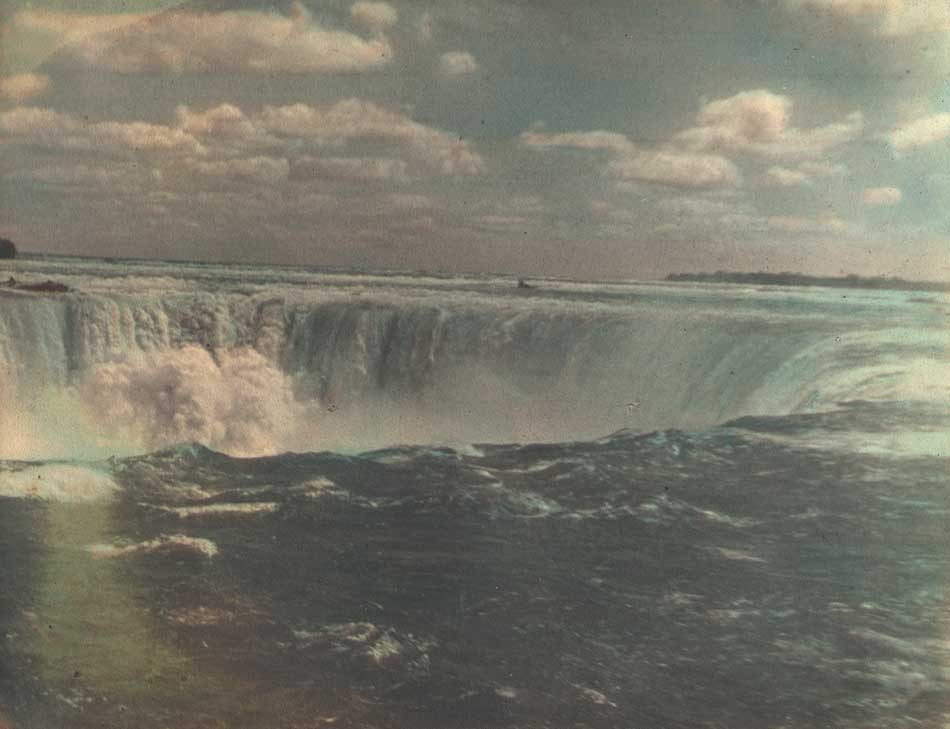 “Niagara Falls”: attributed to Arthur Hammond, American: born England: 1880-1962: hand-colored gelatin silver print mounted to album leaf, ca. 1930-1940: 19.2 x 24.2 | 25.0 x 32.7 cm. To conclude our post is a view of the ultimate Summer Stream: a view showing the Niagara River’s Horseshoe Falls from the Canadian side. From a personal album of nearly 100 photographs attributed to Hammond dating from around 1910-1940. Born in London, photographer Arthur Hammond arrived in America at Ellis Island in New York Harbor on July 31, 1909 and established himself with his own studio in Natick, MA outside Boston by 1912. In 1920, he authored the foundational book "Pictorial Composition in Photography" and became a leading voice for pictorialism in America through his position as associate editor of American Photography magazine that lasted 30 years from 1918-1949. From: PhotoSeed Archive
“Niagara Falls”: attributed to Arthur Hammond, American: born England: 1880-1962: hand-colored gelatin silver print mounted to album leaf, ca. 1930-1940: 19.2 x 24.2 | 25.0 x 32.7 cm. To conclude our post is a view of the ultimate Summer Stream: a view showing the Niagara River’s Horseshoe Falls from the Canadian side. From a personal album of nearly 100 photographs attributed to Hammond dating from around 1910-1940. Born in London, photographer Arthur Hammond arrived in America at Ellis Island in New York Harbor on July 31, 1909 and established himself with his own studio in Natick, MA outside Boston by 1912. In 1920, he authored the foundational book "Pictorial Composition in Photography" and became a leading voice for pictorialism in America through his position as associate editor of American Photography magazine that lasted 30 years from 1918-1949. From: PhotoSeed Archive
By the Stream
Paul Laurence Dunbar (1872-1906)
By the stream I dream in calm delight, and watch as in a glass,
How the clouds like crowds of snowy-hued and white-robed
maidens pass,
And the water into ripples breaks and sparkles as it spreads,
Like a host of armored knights with silver helmets on their heads.
And I deem the stream an emblem fit of human life may go,
For I find a mind may sparkle much and yet but shallows show,
And a soul may glow with myriad lights and wondrous mysteries,
When it only lies a dormant thing and mirrors what it sees.
New Year in New England
Posted January 2019 in New Additions, Significant Photographers, Typography
Happy New Year!
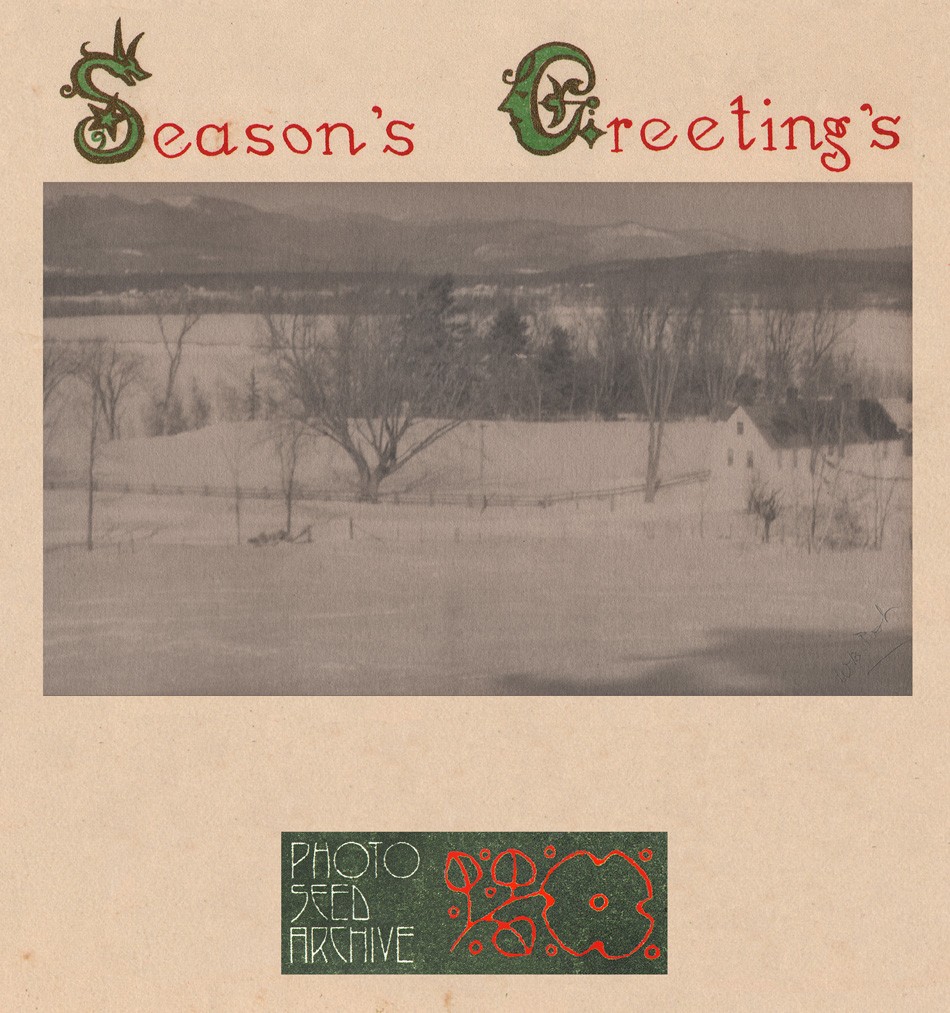 Detail: “White Mountains, N.H. from Rivercroft Farm”: By William Boyd Post, American (1857-1921): vintage platinum print ca. 1900-10 (12.7 x 23.7 | 16.0 x 25.9 cm) Showing a mountainside farmstead in foreground neatly framed by the peaks of New Hampshire's White Mountains in background, the photographer framed this view from an overlook in Fryeburg, Maine on the present-day Rivercroft Farm, first established in 1799 and located at 48 River Street. (ME Route 113) W.B. Post specialized in snow scenes first beginning around 1895, and more so after he retired to his family’s summer home in Fryeburg, Maine permanently in 1898. Ornamental initials and hand lettered greeting on upper margin taken from 1933 folio of colored collotype views issued by an American tea merchant living in Japan. From: PhotoSeed Archive
Detail: “White Mountains, N.H. from Rivercroft Farm”: By William Boyd Post, American (1857-1921): vintage platinum print ca. 1900-10 (12.7 x 23.7 | 16.0 x 25.9 cm) Showing a mountainside farmstead in foreground neatly framed by the peaks of New Hampshire's White Mountains in background, the photographer framed this view from an overlook in Fryeburg, Maine on the present-day Rivercroft Farm, first established in 1799 and located at 48 River Street. (ME Route 113) W.B. Post specialized in snow scenes first beginning around 1895, and more so after he retired to his family’s summer home in Fryeburg, Maine permanently in 1898. Ornamental initials and hand lettered greeting on upper margin taken from 1933 folio of colored collotype views issued by an American tea merchant living in Japan. From: PhotoSeed ArchiveChristmas Wish
Posted December 2018 in New Additions
“In the beginning was the Word, and the Word was with God, and the Word was God…And the Word became flesh and dwelt among us, and we beheld His glory, the glory as of the only begotten of the Father, full of grace and truth” (John 1:1,14)
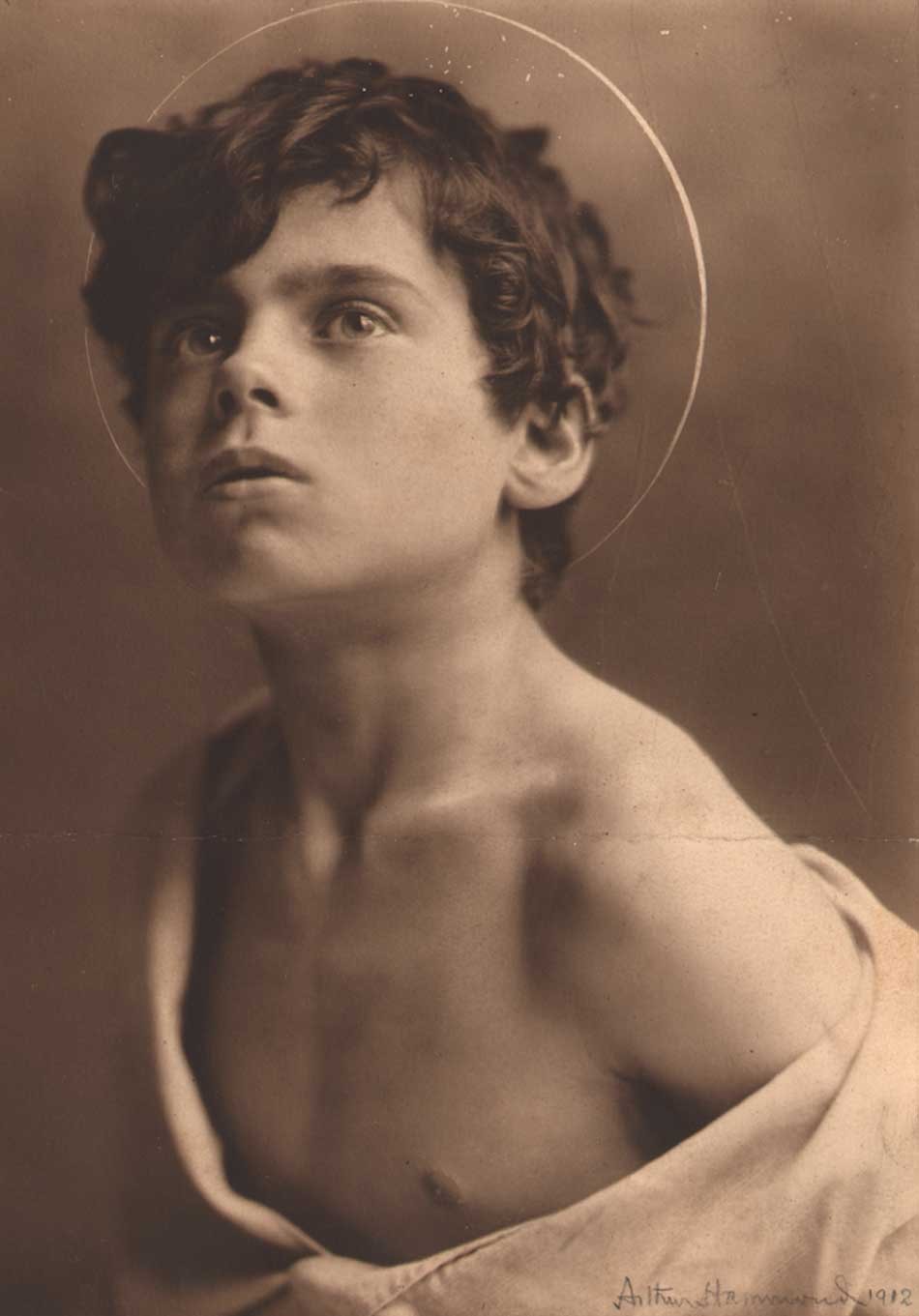 Detail: “St. John”: Arthur Hammond, American: born England:1880-1962: vintage bromide print mounted to album leaf, 1912: 20.8 x 15.6 | 25.0 x 32.7 cm. Dating from 1910 or slightly earlier, this portrayal of St. John the Apostle is represented by the haloed, allegorical form of a young child looking to heaven and dictating his Gospel to his disciple. From a personal album held by this archive of nearly 100 photographs attributed to Hammond dating ca. 1910-1940. Born in London, the artist arrived in America at Ellis Island on July 31, 1909 and established himself with his own studio outside Boston by 1912. In 1920, he authored the foundational book "Pictorial Composition in Photography”, in which this portrait served as the frontis. Hammond would go on to become a leading voice for pictorialism in America through his position as associate editor of American Photography magazine from 1918-1949. From: PhotoSeed Archive
Detail: “St. John”: Arthur Hammond, American: born England:1880-1962: vintage bromide print mounted to album leaf, 1912: 20.8 x 15.6 | 25.0 x 32.7 cm. Dating from 1910 or slightly earlier, this portrayal of St. John the Apostle is represented by the haloed, allegorical form of a young child looking to heaven and dictating his Gospel to his disciple. From a personal album held by this archive of nearly 100 photographs attributed to Hammond dating ca. 1910-1940. Born in London, the artist arrived in America at Ellis Island on July 31, 1909 and established himself with his own studio outside Boston by 1912. In 1920, he authored the foundational book "Pictorial Composition in Photography”, in which this portrait served as the frontis. Hammond would go on to become a leading voice for pictorialism in America through his position as associate editor of American Photography magazine from 1918-1949. From: PhotoSeed ArchiveBluebeard Blues
Posted October 2018 in Alternate Processes, New Additions
Happy Halloween!
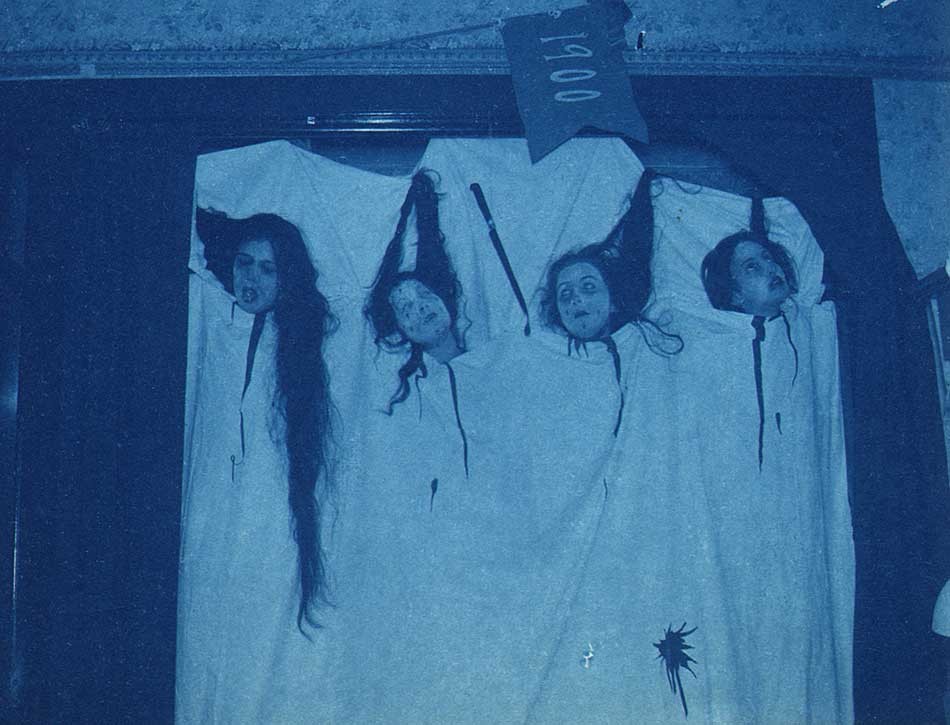 Detail: "Bluebeard's Wives" (Halloween, Tenney House at Smith College) Unknown American photographer: Cyanotype: ca. 1900 (7.4 x 9.6 cm | 18.2 x 27.5 cm loosely inserted within thin, manilla album leaf) During a Halloween party in Northampton, Massachusetts, Smith College students have some ghoulish fun portraying themselves as some of the decapitated wives done in by the hand of a French nobleman. This villain, known as Bluebeard, comes from the European folktale "Barbe bleue" first made famous by author Charles Perrault in 1697. Wikipedia says Bluebeard "tells the story of a wealthy violent man in the habit of murdering his wives and the attempts of one wife to avoid the fate of her predecessors. "The White Dove", "The Robber Bridegroom" and "Fitcher's Bird" (also called "Fowler's Fowl") are tales similar to "Bluebeard". From: PhotoSeed Archive
Detail: "Bluebeard's Wives" (Halloween, Tenney House at Smith College) Unknown American photographer: Cyanotype: ca. 1900 (7.4 x 9.6 cm | 18.2 x 27.5 cm loosely inserted within thin, manilla album leaf) During a Halloween party in Northampton, Massachusetts, Smith College students have some ghoulish fun portraying themselves as some of the decapitated wives done in by the hand of a French nobleman. This villain, known as Bluebeard, comes from the European folktale "Barbe bleue" first made famous by author Charles Perrault in 1697. Wikipedia says Bluebeard "tells the story of a wealthy violent man in the habit of murdering his wives and the attempts of one wife to avoid the fate of her predecessors. "The White Dove", "The Robber Bridegroom" and "Fitcher's Bird" (also called "Fowler's Fowl") are tales similar to "Bluebeard". From: PhotoSeed Archive